MIAMI
In a tribute to the 75th anniversary of Everglades National Park, the University proudly showcases its ongoing efforts to protect and restore this complex and beguiling ecosystem.


In a tribute to the 75th anniversary of Everglades National Park, the University proudly showcases its ongoing efforts to protect and restore this complex and beguiling ecosystem.

THE WORLD NEEDS BOLD THINKING to solve our greatest challenges. It needs bright minds focused on ideas today that will improve our collective tomorrow. By supporting the U, research and discovery can be accelerated to improve the human condition around the globe.
Visit everbrighter.miami.edu to empower discovery that makes a difference.

The highly specialized 94,000square-foot facility will focus on research at the molecular level and will enable the University to provide global solutions

In honor of the 75 years since the dedication of Everglades National Park, herpetologist Hunter Howell takes us deep into this dynamic ecosystem to understand its creepy, crawly, fascinating inhabitants

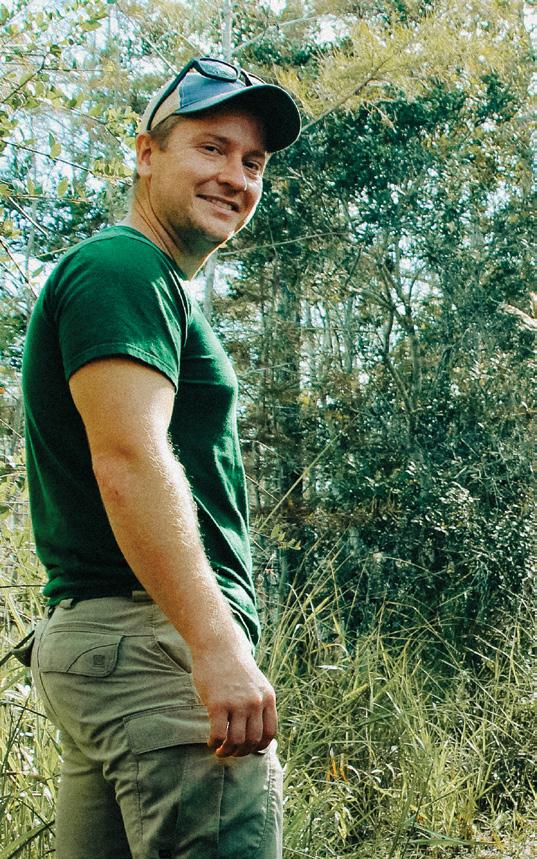
A surgically implanted brain computer interface gives a young man who is paralyzed new control over his life—and control of a race car .
The University went into full gear to prepare for the storm and quickly provided outreach in the aftermath

Executive Vice President for Public Affairs and Communications and Chief of Staff to the President Rudy Fernandez, M B .A ’10
Senior Vice President for Development and Alumni Relations
Joshua M Friedman
Vice President for University Communications
Jacqueline R Menendez, B .A ’83
Associate Vice President, Campaign and Strategic Initiatives
Darlene Rebello-Rao
Assistant Vice President, Communications Charisse Lopez-Mason, M A . ’06
Assistant Vice President, Communications and Public Relations
Peter E Howard
Executive Director, Communications Meredith Camel, M F A ’12
Miami is published by the University of Miami Office of University Communications Reproduction in whole or in part without written permission is prohibited Distributed free of charge to alumni and friends of the University . Postmaster and others, please send change of address notification to Miami, Office of Alumni Relations, P O Box 248053, Coral Gables, Florida 33124-1514; telephone 305-284-2872 Contributions of articles, photographs, and artwork are welcome; however, Miami accepts no responsibility for unsolicited items .
The comments and opinions expressed in this magazine do not necessarily reflect those of the University of Miami or the staff of Miami Copyright ©2022, University of Miami An Equal Opportunity/Affirmative Action Employer
With thousands of new ’Canes arriving—2,820 to be exact —from countries across the world to join the expanding University family, the Coral Gables Campus pulsed with excitement for the launch of the Fall 2022 semester . New students and transfers were treated to a potpourri of 225 different events that welcomed them to learn about the U, the community, and the many resources available to them .



From the recently revamped move-in week, coordinated by the Department of Orientation and Commuter Student Involvement, to welcome events with President Julio Frenk and other University administrators, new and returning students began a semester of highly interactive and innovative learning at the University

The school’s academic and research scope has grown exponentially
From humble beginnings as a small educational program that operated on a shoestring budget out of a Miami Beach boathouse in the 1940s, the “Marine Laboratory” has outgrown its identity and now its name

The new name for what has become one of the nation’s premier earth science schools, the “Rosenstiel School of Marine, Atmospheric, and Earth Science,” became official in June .
Adding “Earth” to the new name, says Jeffrey Duerk, executive vice president for academic affairs and provost, “is an accurate reflection of the scope and scale of the research and educational opportunities the Rosenstiel School now offers . ”
In its earliest years, the school focused solely on marine science, yet the breadth and depth of Rosenstiel’s research and teaching have grown
exponentially over the past few years to include studies not only of the Earth’s atmosphere and oceans but of its geology .
The name change, says Dean Roni Avissar, reflects this extraordinary growth .
“The environmental challenges faced by our planet, most notably in the burgeoning climate emergency, which affects everything from the atmosphere and oceans to rainforests and wildlife, seem insurmountable,” Avissar says
“The Rosenstiel School has been at the forefront in helping to solve those problems for many years, and now we have a name that reflects our complete mission,” he adds .
Avissar highlights recent achievements assisting that mission, including
reorganizing the school into five departments: Ocean Sciences, Marine Geosciences, Marine Biology and Ecology, Atmospheric Sciences, and Environmental Science and Policy
Along with the name change, the school now has a new URL, earth miami edu, and Twitter handle, @MiamiRosenstiel, to boot . Email addresses also have been updated to reflect the name change
Miami Herbert Business School earns prestigious triple-crown accreditation

walk the walk—we shape the future,” says Dean John Quelch “This latest accreditation recognizes our continuing progress . ”
All three organizations assess schools based on factors such as internationalization, faculty, and research The AMBA accreditation— which represents the highest standard of achievement in postgraduate business education—is the only one that focuses on MBA programs specifically
Early this fall, the Patti and Allan Herbert Business School was awarded the Association of MBAs (AMBA) accreditation and joined an elite group of the world’s leading business schools that hold the triple-crown accreditation status The Miami Herbert Business School is one of only three in the country to earn the coveted designation .
Achieving triple-crown accreditation means that the school has earned
accreditation from the Association to Advance Collegiate Schools of Business, EFMD Quality Improvement System, and the AMBA—the three most prestigious business school accreditation organizations .
“At Miami Herbert, we cultivate a premier learning community that values diversity, technology, a global mindset, and sustainable prosperity We don’t just talk the talk, or only
The AMBA’s accreditation panel highlighted the school’s commitment to teaching in small class sizes, investment in faculty, and research capability .
“We are pleased to see the continued recognition of the quality of education provided by Miami Herbert Business School,” says David Mullings, B .S . ’00, M B A ’03, chair and CEO of Blue Mahoe Capital Partners Inc . Mullings was among University alumni consulted as part of the accrediting process
Students craft floating houseboats for architecture competition
Lauren Elia has long been fascinated by Japanese culture and architecture . A recent School of Architecture competition in partnership with Go Friday, the Portugal-based design firm known for its innovative floating structures, provided the fourth-year student the perfect opportunity to explore and create while factoring for sustainability concerns in materials and design
“I really took a dive into Japanese clothing, fashion, lifestyle, and food— and all the nuances of everyday Japanese life—trying to apply a more modern language of architecture that fit Go Friday’s narrative of eco-steel and glass innovations,” Elia explains .
Her project, a Japanese-inspired houseboat, floated to the top of a multitude of innovative design projects and earned Elia the top prize: 1,000 euros and a trip to Portugal
Elia was one of 18 architecture students who participated in the unique competition to create floating houses and dwellings that could withstand strong weather, expected to become more severe with the effects of climate change . Besides the cash prizes, the top three winners get a 10-day trip to Portugal

Lecturer Veruska Vasconez, B .Arch . ’03, M .A .S .T . ’04, taught the six-week
summer studio that included a Go Friday presentation to provide the basics of building a houseboat Students were shown a prototype, then, for their projects, were instructed to choose where their houseboat would reside and to consider sustainability concerns for that locale .
“Each student was asked to pick a country and a location, and to think of the problems with the environment and the problems that we are suffering with sea level rise and overpopulated cities,” explains Vasconez, adding that the notion of living in houseboats is especially germane to Miami, where flooding is getting worse as sea level rises .
“Beyond that, they were given an open canvas—a good architect should be able to take a houseboat idea and create communities that provide a good living,” she adds
Dean Rodolphe el-Khoury says the competition embodied the priorities and learning objectives of the architecture program .
“We want our students to deal with real-world problems and to engage with stakeholders,” the dean points out . “We also value travel and immersion in different cultures I cannot think of a better opportunity than this competition to embrace the pedagogy of our school . ”
Second-place winner Vanessa de los Angeles Crespo and partner Ana Yu won 750 euros for their design of a houseboat compound in La Parguera, Puerto Rico The project gave them a chance to explore how to build an entire ecosystem based on mangroves in the popular seaside town Crespo is a native of the island .
The duo’s design was a two-story houseboat built with concrete and foam to provide buoyancy, an open first floor with columns, and a second floor lined with windows and trusses that are made of recycled plastic and can be shuttered in case of a storm .
“One of the challenges was that we had never built in the ocean,” said Crespo . “So, how can we build a sustainable city that is not terrestrial and fit our project among the mangroves?”
Isacio Javier Albir and Tiffany Agam took third place and were awarded 500 euros for their Aria project, an innovative concept for grid system floating platforms that can be customized to create different configurations With the Paris Olympics as their venue, the two introduced ways to promote Go Friday as part of a living exhibition on the Seine River through cafés, viewing platforms, and living spaces for dignitaries in the 2024 Paris Olympics
A Thanksgiving gathering hosted two years ago by famed Miami recording artist Gloria Estefan, B .A . ’73, proved to be the musical inspiration for “Estefan Family Christmas,” a Frost School collaboration featuring Dean Shelly Berg that dropped this fall as a Sony-produced digital album

The get-together prompted a “pang of nostalgia” for Estefan when, during an after-dinner sing-along, she noted how the “little child voice” she was used to hearing from her grandson Sasha was changing now that he was nearly a teen
That pang prompted action . Estefan and Emily, her daughter and a popular performer herself, moved to capture this special time in a family Christmas album for all to enjoy .
The initiative kicked into fast tempo when Estefan reached out to Berg, with
whom she’d collaborated in the past .
Berg ultimately co-produced the recording, wrote the arrangements and orchestrations, and played piano and keyboards Lee Levin, B M ’89, played drums Professor Steve Guerra contracted an entire big band that consisted of Frost students, faculty members, and alumni for two songs
A trio made up of two Frost students and Steve Gleason, a lecturer in contemporary music, sang background vocals . David Anderson, a professor for Frost’s Gospel Ensemble, prepped and conducted a small group of singers for the session . The Miami Children’s chorus, conducted by Liana Salinas, B .M . ’13, appeared on several songs Other Frost personnel collaborated as well .
The production hit all the high notes Estefan had hoped for “We wanted to celebrate family and the things that
bring us together as human beings,” she explains . “If people can feel even half the love we felt creating this recording, we’ve done our job .”
New minor reflects heightened interest in the Deaf community

Growing interest in the Deaf community and its unique language in popular culture and on campus, as evidenced by the increased popularity and diverse participation in the American Sign Language (ASL) club and classes, led to the launch this fall of a new ASL minor through the School of Education and Human Development . The school also debuted a disability and society cognate Kirsten Schwarz, a lecturer in the school’s Department of Teaching and Learning, teaches the 15-credit sequence of ASL
classes and serves as the club’s advisor . She highlighted changes in the composition of the classes and club where students learn the language and the skills for careers in government, education, health care, social services, business, and technology that serve the needs of the Deaf community and other populations with disabilities
“Previously the club was a lot of education majors, psychology students, and a ton of premed students, but now it’s really built out, and membership is more diverse,” Schwarz notes .
The movie “CODA” (Child of Deaf Adults), which featured deaf actors and won multiple 2022 Oscar awards, prompted a surge of interest in the Deaf community .
“The movie was huge for people realizing what it’s like to be deaf and appreciating that perspective,” says Schwarz “We’ve seen a huge shift in the media in the last four or five years, and ‘CODA’ accentuated that .”
Fatima Navarro, a sophomore who joined the ASL club and served as its events chair after taking the first two classes in the ASL sequence, is among the many students who have gravitated to the coursework
“There’s a sense of exclusion of the Deaf community . Everyone treats them as if there’s an abnormality or distant language gap—and actually they’re just like everyone else and are able to live as we do with the exception of hearing,” Navarro says .
“
For decades, scientists at the University’s Barbados Atmospheric Chemistry Observatory (BACO) have relied on analyzing dust concentrations captured in clear mesh filters mounted atop a 55-foot tower on a Barbados bluff to understand how the tiny particles affect clouds, climate, and air quality .
The dust plumes, which emanate from the North African Sahara Desert, are buffeted by strong winds across the Atlantic and onward to Barbados—the first land mass in the Caribbean Basin—and the Americas . Understanding how the particles are produced and transported serves as a critical indicator and predictor of climate change .
Despite the import of those observations, researchers who have worked at and relied upon data generated by BACO have long believed the observatory was underutilized .
Now, a $1 million National Science Foundation (NSF) grant will unlock a much fuller potential

“This funding is much more than an upgrade,” says Cassandra Gaston, the atmospheric chemist at the Rosenstiel School of Marine, Atmospheric, and Earth Science who spearheaded the grant proposal to refurbish the BACO site she has operated for the past three years .
“It’s really a rebirth, a reimagining,” she notes “We’ll still deploy filters to look at African dust transport But the new instruments we’re getting will allow us to take measurements we’ve never been able to do before ”
The facility’s 3½-story tower will be replaced And a suite of new instrumentation—from a trace metal monitor to an aerosol chemical speciation device—will be brought in via cargo ship, allowing researchers to take measurements that improve climate models in real time and to study indicators of pollution, smoke, black carbon, and ocean emissions .
An upgraded BACO facility will attract researchers from across the University and from around the world to conduct research of their own and likewise fuel additional collaborations at the Rosenstiel School
Paquita Zuidema, professor and chair of the Department of Atmospheric Sciences—who partnered with Gaston on the NSF grant proposal to upgrade the site and whose research focuses on the relationship of warm, shallow clouds to the large-scale environment—says an upgraded BACO will allow her to “puzzle out” how dust and smoke affect trade wind cumulus clouds .
A revamped Barbados facility will directly impact research that will be conducted at the new University Center for Aerosol Science and Technology, which officially launches early next year . The center, which will prompt multiple interdisciplinary collaborations, will study the way in which aerosols affect the environment, climate, and human health
Pratim Biswas, a renowned aerosol scientist and dean of the College of Engineering, envisions using the smaller aerosol-monitoring sensors from his lab in concert with newly installed instruments at the Barbados site to conduct air-quality studies of all kinds
“BACO has generated a tremendous volume of data,” says Biswas, who partnered with Gaston on the NSF grant proposal to upgrade the site . “With the improvements, it’ll only get better ”
For Joseph Prospero, the legendary atmospheric scientist and Rosenstiel School emeritus professor who, in 1971, established the observatory at Ragged Point on the easternmost edge of Barbados, the impending upgrades are a dream come true .
Back in the 1960s, it was Prospero and his colleague, Toby Carlson, who discovered the phenomenon of Saharan dust transport and the Saharan Air Layer, reporting their findings in leading scientific journals Today, meteorologists’ reports about Saharan dust have become part of routine weather forecasts, according to Prospero .
“Now, the work that we’re continuing to do, looking at the relationship of Saharan dust to weather and to climate, is all the more important,” Prospero says .
The new instruments we’re getting will allow us to take measurements we’ve never been able to do before.”
—Cassandra Gaston
Radiology and data science unite to develop innovative tool
The Miller School of Medicine Department of Radiology together with the Institute for Data Science and Computing (IDSC) are designing an artificial intelligence tool geared to help diagnose patients in a more individualized way .
Seeking to free up physicians to spend more time with patients, radiologists Dr . Alex McKinney and Dr . Fernando Collado-Mesa have teamed with the IDSC to create an artificial intelligence toolbox that will draw on a massive database of deidentified data and medical images, intel that will help doctors diagnose and treat diseases based not only on imaging data but by also considering a patient’s unique background and circumstances .
“We believe the next iteration of artificial intelligence should be contextual in nature, which will take in all of a patient’s risk factors, lab data, past medical data, and help us follow the patient,” says McKinney, who is also the chair of the Department of Radiology
The new AI toolbox will indicate whether disease is present and, if it is, associate data individualized for the patient that includes risk factors such as race and ethnicity, socioeconomic and educational status, and exposure
The radiologists sought a tech-based partner to help more efficiently sift through the mountains of data IDSC director Nick Tsinoremas, also a professor of biochemistry and molecular biology, and an advanced computing
team developed the idea of utilizing an existing tool—URIDE, a web-based platform that aggregates deidentified patient information for faculty research—and adding the deidentified images from the Department of Radiology .
A first version of the toolbox, which will include millions of CT scans, mammograms, and ultrasound and MRI images, along with radiographs, is expected this year .
I nitiative reinforces University’s engagement throughout the Americas
The University will host the annual Americas Summit for the next three years as part of its partnership with Concordia, a leading global convener widely recognized for hosting the largest and most inclusive nonpartisan affairs forum alongside the U .N . General Assembly The 2023 event will take place March 9-10 on the Coral Gables Campus .
“One of our responsibilities and privileges as a comprehensive research university is to bring together leading thinkers around pressing global issues,” says University President Julio Frenk . “We are delighted to serve as a point of connection for the Americas, and we look forward to working with Concordia to feature relevant research conducted in Miami on issues ranging from climate change to democracy
Following the 2023 Americas Summit, Concordia and the University will collaborate on the 2024 and 2025 Americas summits, with the University hosting those events as well Key experts and researchers from the University will regularly contribute to Concordia annual and regional summits
The partnership is being supported through a gift from University of Miami Trustee Emeritus Jose Bared, B S M E ’64, whose Bared Family Foundation views the partnership with Concordia as an important avenue for continuing
the University’s engagement in the Western Hemisphere .
“The University of Miami has, from its founding, helped shape the thinking around important issues affecting our hemisphere,” says Bared . “The platform provided by this partnership with Concordia builds on that tradition and creates new opportunities for connection ”

The Concordia Americas initiative began in 2016, with the inaugural summit in Miami and subsequent convenings in Bogotá, Colombia, gathering leaders from the public, nonprofit, and private sectors to explore the most pressing issues facing the Western Hemisphere .
In July the University hosted the 2022 Americas Summit, which featured an impressive list of speakers, including current and former heads of state, business leaders, public servants, researchers, and activists rooted in a common bond and desire—as Frenk noted—“to see this hemisphere reach its full potential ”

As a lawyer, David Yellen argued before the U .S . Supreme Court, served as counsel to the U .S . House Judiciary Committee, and worked for many years in reforming the country’s criminal justice system . As an administrator, he served as president of Marist College and law school dean at Hofstra University and Loyola University Chicago Yellen has been frequently recognized as one of the most influential people in legal education .
Last year when he bumped into longtime friend Nell Newton, then the interim dean at the University of Miami School of Law, Yellen was ensconced in his role as CEO of the Institute for the Advancement of the American Legal System, a research center that works nationally to improve the effectiveness of Americans’ access to the civil justice system Newton told him that the School of Law was looking for a full-time dean and that he would be a perfect fit
Few would have questioned if Yellen had declined the invitation . The father of three and grandfather of two (with a third due in January) had already reached impressive heights in his career, a pinnacle for most . Yet he clearly still has a sense of adventure
“The appeal was not just a great law school in a cool place, but one that was poised for a new chapter where what I’m good at and what I like to do in higher-ed leadership might be a really good match,” says Yellen
Born and raised in Paramus, New Jersey, Yellen describes his upbringing as “typical middle class ” Yet, he remembers his parents, father Arnold and mother Beverly, as being “ahead of their time ”
Both evolved as their careers unfolded, his father in the insurance business, his mother rising from a secretary to a marketing manager at a company that sold calendars and other business supplies
While he was talented at a number of sports, Yellen excelled in the classroom He was president of the National Honor Society, earned high grades, and was accepted to Princeton University, where he went on to earn his B A magna cum laude He earned his J .D . in 1984 from Cornell University .
After receiving his law degree, Yellen completed a clerkship in Nebraska He went into private practice and later moved to government work, serving as counsel to the U S House Judiciary Committee .
He was appointed dean of Hofstra University in 2001 and served for three years . In 2005, Yellen moved to Chicago to take the helm at Loyola University Chicago School of Law Afterward, he served as president of Marist College from 2016 to 2019 .

Yellen assumed the reins of the School of Law on July 1 . He is developing ideas for a long-range plan and vision that include introducing master’s degree programs for non-lawyers as he did at Loyola, expanding the school’s international law program, exploring ways to recruit more international students, and providing a more robust learning experience for U S students seeking international work
He’s inspired to learn more about the burgeoning tech scene in Miami to see if that’s an area where the School of Law could help train the next generation of tech lawyers .
“Our job will be to enhance an already great program of education for our students, support the scholarship and public service by our faculty that set this law school apart, build our reputation nationally and internationally, and grow our programmatic revenue and fundraising to pay for all of this,” he says .
New facilities increase access to care
UHealth—University of Miami Health System launched a satellite location to care for patients in Doral and has broken ground on a major facility in North Miami .
When completed in 2025, UHealth at SoLé Mia will be UHealth’s largest ambulatory site The 7-story, 363,000square-foot medical center will be part of SoLé Mia, the 184-acre, mixed-use development in North Miami developed by the Soffer and LeFrak families
“Envisioning and then building a medical facility of this magnitude doesn’t happen by chance,” says University of Miami President Julio Frenk “It comes from a commitment to being a preeminent academic health system and from people [who] are committed to excellence and improving access to health care .”

Dr Dipen J Parekh, chief operating officer of UHealth, noted the new health care destination will include specialists from the Sylvester Comprehensive Cancer Center, the only cancer center in South Florida to earn designation from the National Cancer Institute; Bascom Palmer Eye Institute, the top-ranked eye hospital in the country; the Desai Sethi Urology Institute; and from UHealth’s nationally ranked neurology and neurosurgery programs .
Both the North Miami and Doral locations will be modeled after UHealth’s award-winning Lennar Foundation Medical Center, which opened in December 2016 on the University of Miami Coral Gables Campus .
In mid-September the Doral medical facility opened the first phase of the two-phase project, which will culminate in 2024 with a 6-story, 150,000-square-foot multidisciplinary medical center The first phase includes an 18,000-square-foot facility in an existing building in downtown Doral offering services from specialists at the Desai Sethi Urology Institute and Sylvester Comprehensive Cancer Center In addition to urology and oncology, other health care services include primary care, cardiology, neurology, and ophthalmology .
Speaking to hundreds of attendees at the Shalala Student Center in September, as well as an audience watching virtually, President Julio Frenk noted that the University of Miami remains on course to meet the objectives of its ambitious strategic plan—the Roadmap to Our New Century

“Resilience is a quality the U knows well,” Frenk shared in the State of the University address “Throughout our history, we have repeatedly overcome challenges by adapting to changing circumstances Our strategy is no exception . If we are to reach our goals by 2025, the status quo will not suffice .”
The pandemic created dramatic disruptions and opportunities that are shaping endeavors throughout the
University’s four pillars: the academic core, health care, intercollegiate athletics, and technological innovation
“Success in one supports, enhances, and helps drive success in others,” Frenk remarked about the pillars “Our innovation in the classroom draws accomplished scholars . Our school spirit—driven by exciting wins in every field of competition—cements our passion for the U . Our life-changing discoveries in the lab give us the tools to improve health, to partner with visionaries, and to serve our communities .”
Weathering these disruptions required laser-focused execution, which is why the institution made a key strategic move, naming Joe Echevarria, B B A ’78, executive vice president for health affairs and CEO of UHealth, as the University’s
first chief executive officer, Frenk told the audience
“There is no substitute for hard work,” Frenk said . “This means being deliberate, not just about what we do but about how we do it In what we have dubbed Roadmap 2 .0, how we carry out our mission underscores all of our pillars .”
Second round of grant recipients conduct innovative research and service projects
2022–23
Radical Reading Circle creates a co-facilitated group to read, discuss, and advance new ideas and possibilities gleaned from literature to better address social justice concerns
Courtney Giebel is one of the students working with community partners to educate citizens and safeguard their voting rights.
The 305 Give Back Drive funnels resources from larger institutions to local, underserved communities through a back-to-school drive for elementary schools in Miami-Dade County in support of education and advocacy .
Puzzle Pieces Mentoring for Diversity: A Path Forward to Help Future PTs Find the Right Fit! optimizes professional development and networking opportunities, and enhances resume building for Black undergraduate students entering the physical therapy profession .
From safeguarding voting rights in an underserved Coconut Grove neighborhood to creating a library of picture books that reflect young readers’ own racial diversity, the 11 projects awarded funding for the second round of the Racial Justice Grant Program provide an array of innovative ways to promote equity and inclusion
The grants program serves as one component of the University’s broad initiative, launched in the aftermath of the murder of George Floyd, to advance racial justice across the institution and in greater South Florida .
For this second round, awardees were funded in amounts ranging from $500 to $5,000, and projects run through the academic year .
“Voting Rights in Miami’s Historic Coconut Grove Village West” was one of the projects that received the top tier of funding A student team from the Center for Ethics and Public Service at the School of Law is working with community partners to educate citizens and safeguard their voting rights in the underserved neighborhoods of West Coconut Grove
“From working with our partners, we learned that some voters were confused by the many issues and were unsure who they’re voting for, so we did a deep dive using a nonpartisan format to develop a fact sheet on all the candidates,” explains Courtney Giebel, a second-year law school student who galvanized the project

Guerdiana Thelomar, B .S .Ed . ’15, a doctoral candidate in the School of Education and Human Development, coordinates the initiative—from applicant selection to ensuring the funds are delivered and outcomes are reached .
The projects can be either research or service-based and must address racial equity issues or advocacy They are assessed for interdisciplinary focus and degree of engagement, and student teams require community partners and a faculty advisor
Exposing the Expansive and Racially Disproportionate Reach of Mass Incarceration in Miami-Dade County teams students with the organization Beyond the Bars to conduct a canvassing pilot that raises awareness of mass incarceration in Miami-Dade County
STEAM-D Science, Technology, Engineering, Arts, Mathematics and Diaspora is a mentorship program to help Black students in high school gain a better understanding of the skills necessary to go into a variety of S T E A M disciplines
Gender-Based Violence, Racial Justice, and Policing in Miami surveys community organizations to assess perceptions of police interactions with victims of genderbased violence and provides recommendations to police and the county Domestic Violence Oversight Board
YPAR at Power U: Young People Building Power and Organization to Win! is a youth participatory action research project that supports Power U’s mission to develop the leadership of Black and Brown workingclass high school students .
Multicultural Library and Supporting Activities creates a picture book library collection and art exhibit—together with the University’s Linda Ray Intervention Center—that allows students to see clearer reflections of themselves in the books that are read to them .
Prison Visits for Racial Justice aims to dismantle biases and stigmas that students may hold toward incarcerated people and/or people impacted by the criminal justice system .
Shadow a UM Student Day provides a shadowing event for a cohort of students from the University’s First Star Academy for them to see the college space physically and envision themselves in it as a person of color
Hospitals have been part of Mauricus Murdock’s life since he was a young boy growing up in innercity Memphis, Tennessee, though in ways that no one would ever wish
He was just 5 when his mother died, days after her 21st birthday, after being transported to the hospital with fatally clogged arteries His grandmother, who raised him after his mother’s death, a few years later collapsed at work, lapsed into a coma, and was rushed to the hospital but died there
And as a college sophomore home for winter break, Murdock was a passenger in a car accident where three of his friends died and he was the lone survivor
While rehabilitating from the leg he lost in that accident, Murdock painstakingly learned to walk again yet also forged the resolve to seek a new future with a professional career: hospital administration .
Murdock graduates this year from the University of Miami Patti and Allan Herbert Business School with a Master of Health Administration, an 18-month specialized master’s-degree program .
This past summer, as part of the program’s coursework, he earned
a competitive internship at Broward Health Imperial Point
“Mauricus really stood out for us in the interview when we realized how willing he was to learn, that he had done his research and knew more about our organization than most other interns, and just hearing his story demonstrated that he was not someone who shies away from challenges,” explains Faith-Simone Hunte, Broward Health’s corporate director of employee relations and diversity, equity, and inclusion .
The summer internship helped recalibrate his past experiences with hospitals, and his path to graduation validated the belief that his grandmother—whom he endearingly called “Momma”—held for his success through education .

“Momma always told me: ‘Son, you are incredibly smart, you read and speak so well, you can spell so many words that kids your age can’t, and you know so much . So, study hard, and education will take you wherever you want to go,” Murdock recounts .
After the car accident, Murdock spent nearly a year in recovery, both physically and emotionally challenged to push through all he had suffered .
He persevered and even managed to return to his Tennessee college and earn a B .S . in exercise science .
After graduation, he took time off to travel and reflect on his experiences . A call from a Tennessee friend, who was just graduating from the University of Miami with a Master of Health Administration, opened the next door .
You’d be ideal for this program, his friend urged Murdock applied but, even after an upbeat initial interview, doubted he’d be accepted .
“But the following week I got the acceptance letter,” he says “I had done some things in my life and traveled, but now, moving to a totally different city? That was a big leap and a bold adventure, yet something I’d always wanted to do ”
Now in the final stretch of his master’s work, Murdock is super satisfied
with his University experience .
The rigor of the program has made him a more studious and engaged student . He especially benefited from a public health class, teamtaught by Donna Shalala, former University president and former U S Health and Human Services Secretary .
“To take a class with someone who basically wrote HIPAA [Health Insurance Portability and Accountability Act] and other health care policy and laws with the U .S . government, that’s an experience you can’t get anywhere else,” he notes . What has this extraordinary young man learned from the river of trials and tribulations he has navigated in his life so far?
“To really believe in yourself, really push the limits, and never to live by the status quo,” Murdock responds . “I really thank my grandmom for so much . She was the one who made me take academics seriously .”
With an intent to glean the skills necessary to address urgent issues relating to planetary health, 36 students enrolled in the first-ever “Climate Resilience: A Multi-Faceted Approach” course offered this fall semester .
Sophie Walenta, a senior majoring in marine affairs and ecosystem science and policy, was among those immediately interested when she read about the new cross-disciplinary course
“I’d never heard of a class so upfront and modern,” she says . “It’s an urgent class, where the instructors are using an interesting way to go about problem-solving that is so relevant for our generation ”
From the ocean floor to the ionosphere, the three-credit undergraduate course offers a radical new approach to learning Thirteen of the University’s most renowned researchers in environmental issues—from climate modeling to extreme weather, coral reefs, coastal protection, sustainable building, disaster management, data modeling, and so much more— utilize a flipped learning method to stimulate optimum student engagement across the 12 modules of the course .
“We are fortunate to have world-class faculty at the University who are eager to share their expertise with our students through this class and to guide them toward finding viable, sustainable ideas to help our nation tackle
the many unforeseen issues that we will face in a changing climate,” says Jeffrey Duerk, executive vice president for academic affairs and provost
Ali Habashi, assistant professor of cinematic arts, is one of the principal creators of the course . Together with a team of current and former students, the award-winning filmmaker cinematically produced the educational content for the class this summer .
“Climate and resilience issues are often complex and involve a great deal of uncertainty,” says Habashi “We are working to teach our students a way to embrace that uncertainty and have a solid workflow that would allow them to move forward with small, careful but meaningful steps—to develop evidence-based habits, while also understanding the importance of teamwork and collaboration for problem-solving ”
Sonia Chao, professor and associate dean of research in the School of Architecture, also helped design the course, along with other members of the Climate Resilience Academy’s education committee, including librarian associate professor Timothy Norris; engineering professor and associate dean of student affairs Derin Ural; and Matt Acevedo, the University’s director of learning innovation and faculty engagement and executive director of information technology
Chao enjoys working with undergraduate students of all disciplines and envisions the class as part of the first-year experience at the University

“In the same way that English and math are fundamental to a student’s higher learning experience, this course can teach them to become more resilient to climate realities, be it as individuals or as part of their community,” says Chao . “We hope this class will make for great climate leaders . But at the very least, these students will be climate savvy and through the course they can see how they can contribute to developing solutions and driving needed change . This is chapter one of the Climate Resilience Academy, with many more to come ”
Bailey Byers, a sophomore studying architecture, enrolled in “Climate Resilience” and is intent on making sustainable and resilient design a focus of his studies at the University “It’s time in history to do this,” says Byers . “Learning more about climate resilience is one of my passions, so it’s exciting to see the University implement it in a course ”
“It’s time in history to do this.”
—Bailey ByersTeaching assistant Ryan Schooley explains the design-thinking process.
A cross section of University faculty members will join a dream team of scientists nationwide to develop hybrid biological and engineered reef-mimicking structures that can mitigate coastal flooding, erosion, and storm damage
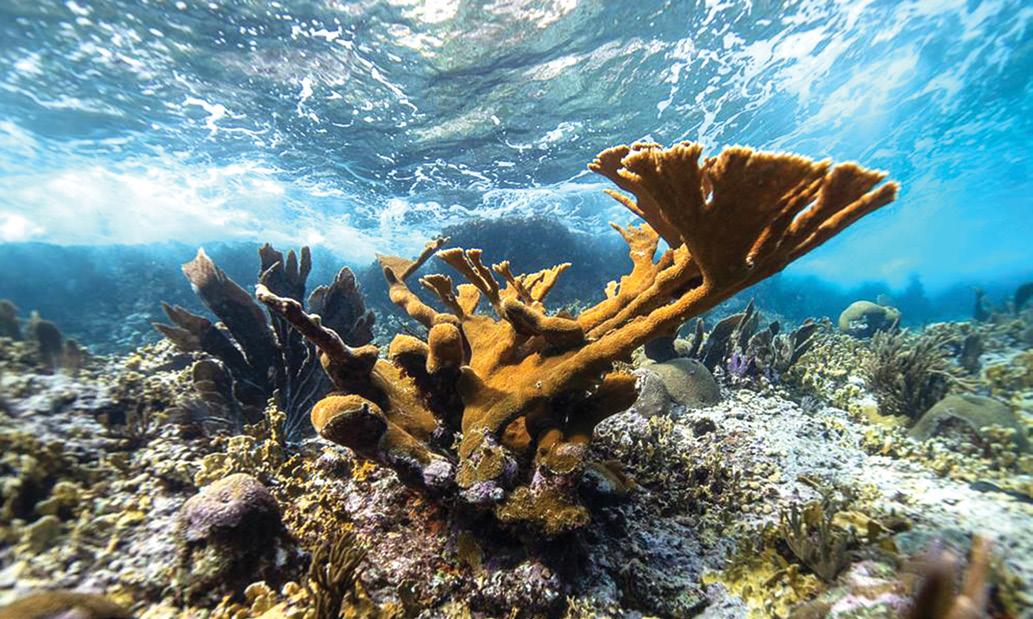
The Rosenstiel School of Marine, Atmospheric, and Earth Science will be the top recipient of funding for an initial $7 .5 million
grant, with options of up to $20 .9 million, from the Defense Advanced Research Projects Agency (DARPA) “Reefense” initiative .
“The overall goal is to develop, test, and deploy coral-reef-mimicking structures that provide immediate protection from waves and which are also selfbuilding, self-repairing, and resilient to climate change,” explains Vivek Prakash, assistant professor in the College of Arts and Sciences
and a specialist in marine organismal biophysics, whose lab will conduct hydrodynamics modeling of the reef
Andrew Baker, Ph D ’99, professor in the Department of Marine Biology and Ecology and director of the Coral Reef Futures Lab at the Rosenstiel School, will serve as principal investigator for the DARPA project .
“We will be working on next-generation structural designs and concrete materials and integrating them with novel ecological engineering approaches to help foster the growth of corals on these structures,” says Baker
The new Miami-based project, called X-REEFS (neXt generation Reef Engineering to Enhance Future Structures) was incubated through the University’s Laboratory for Integrative Knowledge (U-LINK) . For this instance,
the challenge was how to protect the highly urbanized, low-lying sections of South Florida threatened by storm surge and coastal inundation
Brian Haus, professor and chair of the Department of Ocean Sciences, will serve as co-principal investigator for the initiative . In collaboration with Landolf Rhode-Barbarigos, assistant professor in the College of Engineering, Haus has been using the SUSTAIN (SUrgeSTructure-Atmosphere INteraction) facility to study the benefits of hybrid artificial coral reefs for coastal protection
SECORE International, a leading coral reef conservation organization, the Global engineering firm AECOM, and a host of specialists from universities around the country will participate
Nursing science doctoral student Kathryn Gerber will lead a multidisciplinary team of School of Nursing and Health Studies researchers to study the neuroinflammatory biomarkers, symptoms, and functional outcomes of individuals with moderate traumatic brain injury (TBI) .

Gerber received a grant from the Society of Trauma Nurses to study the impact of TBI, a condition resulting from falls, gunshots, and car accidents and which affects an estimated 2 .8 million Americans, with 50,000 deaths and 282,000 hospitalizations annually .
The Centers for Disease Control documents that TBI-related emergency department visits, hospitalizations, and deaths more than doubled between 2006 and 2014 and estimates medical expenditures at $60 billion .
“Our findings will enable more appropriate, evidence-based care to be given to patients who have experienced a traumatic mechanism, namely TBI, and additionally will help guide trauma nurses in their clinical practice to better understand the connection between symptoms and functional outcomes in TBI patients and to anticipate plan of care,” Gerber
says “Longer term, our findings may help biomarkers be incorporated into clinical guidelines and inform future intervention development . ”
TBI, which is categorized as mild, moderate, or severe, is characterized by neuroinflammation and structural damage leading to symptoms and altered brain function . The moderate designation, in particular, has been understudied and their symptoms poorly defined, according to Gerber
Individuals with TBI experience a wide range of symptoms, from dizziness and pain to irritability and memory problems, and they may suffer severe, lifelong impairment
Gerber will conduct her study at UHealth/Jackson Memorial Hospital and plans to utilize the School of Nursing and Health Studies Biobehavioral Lab to analyze the neuroinflammatory biomarkers in blood drawn from study participants .
With so much sports pedigree in her family, it’s little wonder that new ’Canes golf coach Janice Olivencia became a top-notch athlete in her own right

Her mother is a former professional volleyball player in the family’s native Puerto Rico . Her father, a former professional basketball player on the island, is enshrined in their hometown of Caguas’ Hall of Fame . Her grandfather played professional softball, and her aunt excelled at volleyball and also received local acclaim
The surprise is that golf ended up being Olivencia’s sport of choice
“Growing up, golf was not in the picture . I played
tennis, volleyball, basketball, softball—a lot of sports,” she recalls .
Her mom took up the sport of golf first . What began as a hobby for her mother, became a passion for Olivencia And it was one that opened the doors for her to compete internationally, earn a scholarship at the University of Texas, represent her country on the global stage, and this season brought her to Miami to mentor a new generation of golfers as the new head coach .
Olivencia describes the opportunity as both “an honor” and a “privilege,” especially given the program’s rich history .
In 1970, the Hurricanes’ golf team won its first
national championship . And three years later, in 1973, it was the Hurricanes’ golf program that became the first in the nation to award an athletic scholarship to a woman, Terry Williams Munz .
In all, the Hurricanes have won five national titles and produced seven individual national champions .
Charged with helping grow those numbers, Olivencia asserts she’s ready “I’m a competitor, so my objectives are high . I want to contend for championships, to win a conference championship, and to put my team in the best place to succeed—as individuals and as a team,” Olivencia says . “My vision is to get Miami to the top . ”
Mia Vallée knew she faced an uphill climb on the scoreboard during the preliminaries of the 1-meter springboard at the most recent NCAA Women’s Swimming & Diving Championships .

Yet the third-year diver has grown to believe in her skills, both on the springboard and in the classroom, and felt ready for the challenge
She wasn’t wrong .
Not only did Vallée fight her way into a finals field that featured eight of the nation’s top divers, but she went on to win the national championship—in record-breaking style The Canadian-born diver’s total score of 365 756 was the highest ever
“It’s crazy to think about it because I have been able to step it up in finals recently a lot better than I used to,” says Vallée . “Once I made finals, I knew I was going to be able to
dive my best I wasn’t going to hold anything back .”
Vallée, who also went on to earn ACC Women’s Diver of the Year after her memorable season, brings that same championship attitude and dedication to her marine science studies . Last spring, she was among 11 studentathletes honored for their work in the classroom, in the community, and in competition during Miami’s eighth annual Celebration of Women’s Athletics .
It’s an honor that diving head coach Randy Ableman says Vallée more than deserves, given her achievements on the boards and in the classroom .
“Mia’s in the same category as all the great divers we’ve had,” says Ableman . “She never misses a practice She’s really into her sport, and she’s a great student and super, super busy—yet she excels in more than one thing at a time . Plus, she’s a very fun and funny person
and a great teammate . She uplifts other people as well as herself . ”
Vallée concedes that it hasn’t always been easy to stay on top of all her responsibilities Yet, she has improved her time management and organizational skills, and she has found her voice and a comfort level she didn’t quite have as a first-year student
That maturity has translated into a series of honors and awards: Provost’s List, Dean’s List, Athletic Director’s Honor Roll, and All-ACC Academic Team . And now, Vallée has an NCAA Championship on her resume and is well on her way to earning a degree she says she could never have imagined attaining during her childhood in her native Canada
“I’m in an amazing position I don’t think I would have gotten the same marine bio education up in Montreal . I don’t even know that I would’ve even chosen that major had I done my degree up there,” she admits
“And in terms of diving, Miami has allowed me to work with coaches that understand me, and I’m part of a team that is always supportive and uplifting . That makes a huge difference . ”
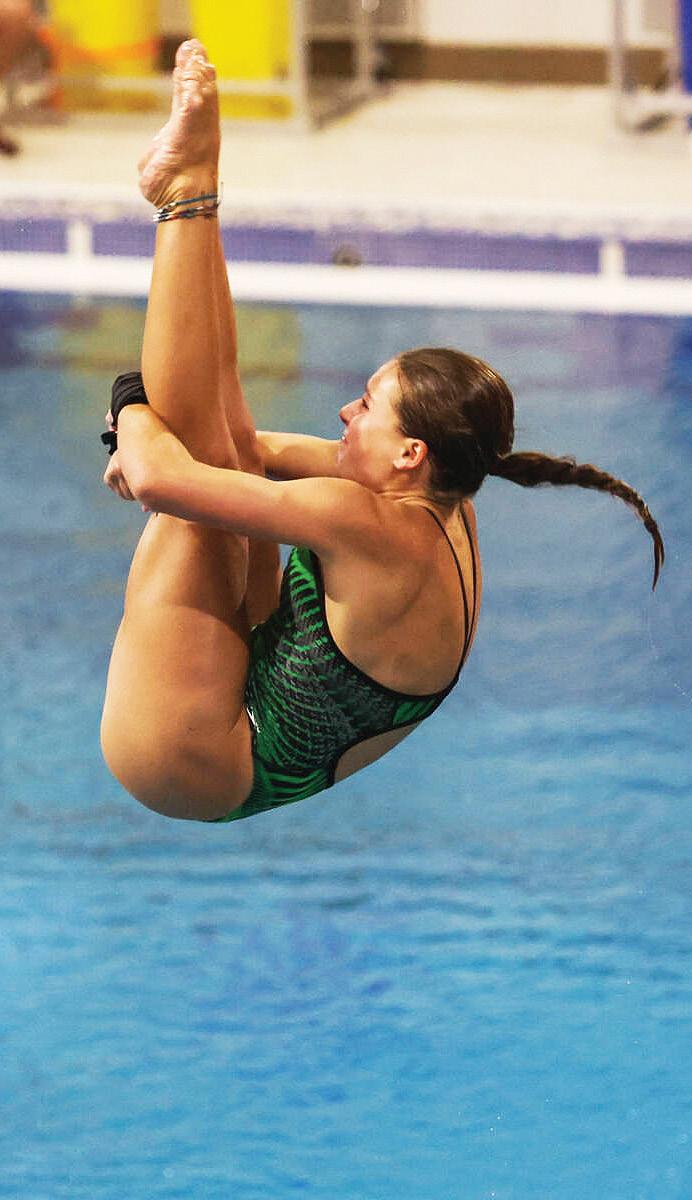
Vallée is already thinking about defending her title next year Beyond that, she has her sights on the 2024 Olympics in Paris and knows a strong finish to her Miami career will only help on that front .
As Priscilla Walker took in the scene around her, she fought back tears .
Her children were tossing around a ball with members of the Hurricanes football team . Others learned routines from Miami’s cheerleaders or colored gratitude rocks with Hurricanes swimmers and divers
And she knew that when the night was over, they would be taking home a Thanksgiving meal put together earlier by members of the football team, some of whom had picked out pies at a grocery store while others packed hams, turkeys, and sides in boxes put together specifically for each family
It was all overwhelming in so many ways
“Having special needs children, children that will
never be able to play a contact sport, having the opportunity to run around and interact with the football players, it meant so much to them,” says Walker .
For the second straight year, the Hurricanes football team welcomed families from the Miami-Dade County Foster and Adoptive Parent Association to the Carol Soffer Indoor Practice Facility to not only provide a holiday meal, but share a few smiles, too

The opportunity to give back to the community— especially at this special time of year—wasn’t something they took for granted
“I know people that have gone through similar experiences as some of these kids and you know, it’s important to give back when you’re able,” offensive lineman Jalen Rivers says .
The world is changing faster than ever, but with the right guidance, you can keep up with it and shape its future. As thought-leaders in the space, we at Miami Herbert have redefined what it means to be a business school and designed a new experience for the new world of business.
Our many programs are tailored to equip a new generation of leaders with the skills needed to manage crises; work through abrupt business changes; and develop innovative the business world of tomorrow. To learn more, visit go.miami.edu/what .
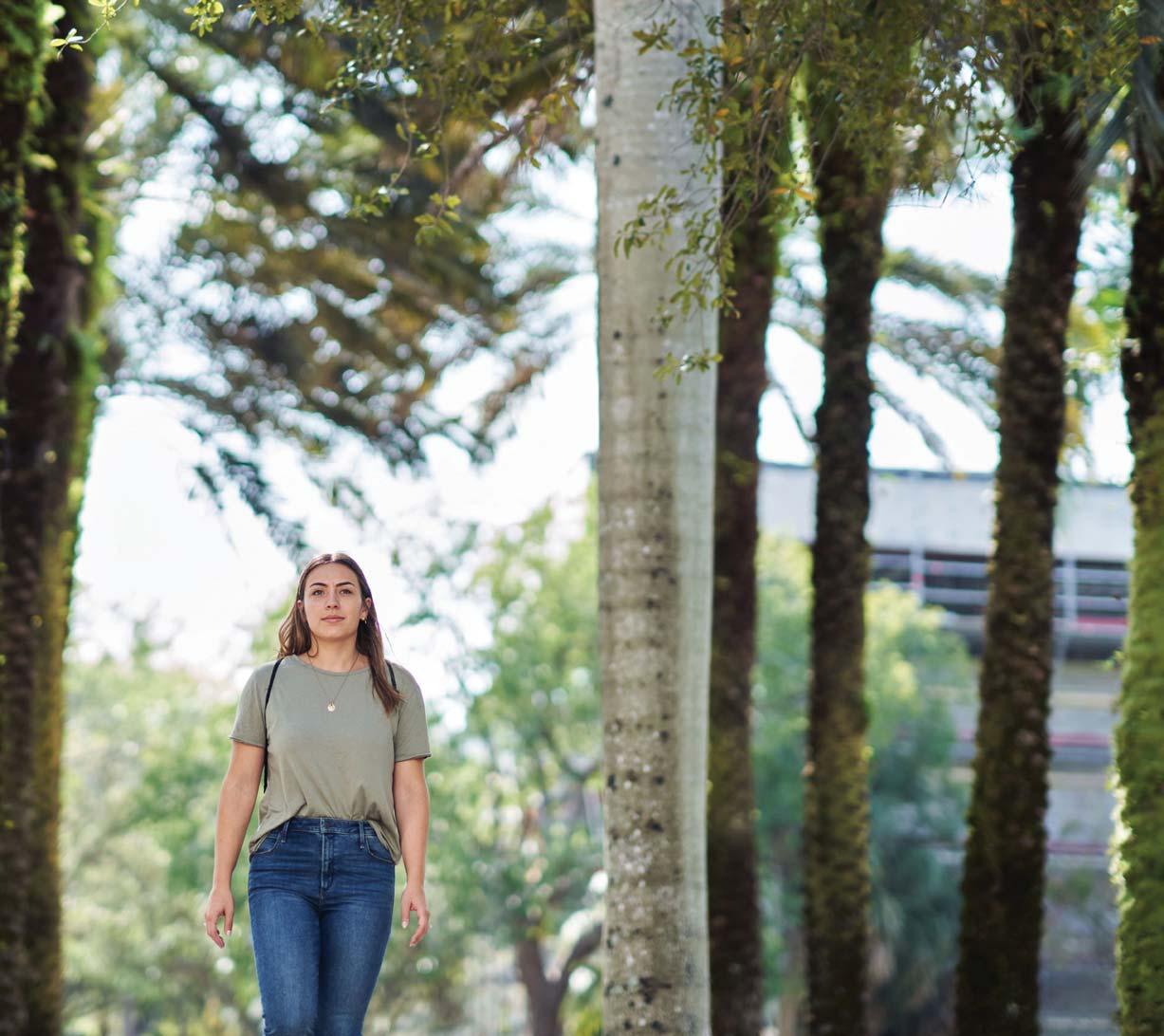


Jennifer Grim fell in love with the sound of the flute in elementary school. She practiced and played joyfully into her college years; yet despite her passion, Grim pursued a career in medicine. Growing up, the associate music professor—today an accomplished and celebrated flutist—never envisioned herself as a professional classical musician.
“It wasn’t something my parents advocated for or against,” explains Grim. “I identify as Black and biracial, and I just never saw anyone who looked like me play classical music.”
This past summer, Grim became the new board president of Chamber Music America (CMA)— the first woman of color to head the organization in its 45-year history. Her aims for the organization parallel those of her teaching and administrative responsibilities with the Frost School of Music: inspiring musicians of color to enter and sustain careers in classical music and especially chamber music.
“There is an air of excitement in the classical music field, and while part of it is has to do with emerging from the pandemic and being able to play again, it also has to do with an increased awareness of inclusivity,” Grim says. “We’re seeing
progress and momentum, not only in who gets hired, but also for the repertoire for these concerts.”
After shifting her studies from medicine to music, Grim earned a Master of Musical Arts and a Doctor of Musical Arts from Yale University. She has performed worldwide both as a soloist and with chamber ensembles and given master classes at many prestigious music schools. The flutist for the award-winning Zephyros Winds, she is also president of the National Flute Association in addition to her new CMA leadership position.

While pursuing her doctoral degree, Grim thrived on the intimacy associated with chamber music—an ensemble of two to eight musicians playing together without a conductor.
“When one plays in an orchestra, they’re part of a large machine that makes a powerful sound, yet when you play chamber, every voice is a soloist. So, you get to be a soloist as well as a supportive partner— that’s what I love about it,” she says.
While her main responsibility at Frost is teaching flute, she is excited to share her passion.
“Chamber music is what I do most as a performer, and I strive to attract students who are also interested in chamber music,”
she explains. “As we come out of the pandemic, I’ll be seeking even more opportunities for musicians of color, looking to form new collaborations and new possibilities here at UM and elsewhere.”
After college, Grim forged her performing career while living in New York City. Now in Miami, she’s intent on creating music hubs outside of the historic music mecca and plans to draw on her previous professional connections and also take advantage of Miami’s expanded artistic popularity.
To support her effort, she’s intent on fostering collaboration with emerging groups and musicians coming out of local schools, especially those too often overlooked because of the
neighborhoods they serve.
Grim often thinks back to a recruiting experience she had years ago when she taught in Las Vegas, Nevada. She visited Cheyenne High School, a Title 1 school, in search of young musicians.
The students observed her curiously and listened intently to her talk. Then one little girl spoke up: “I’ve never seen a black professional flute player before.”
“That was years ago, but I remember it clearly,” Grim recalls. “It reminds me that I have to keep doing this. Again, COVID has made things more difficult. But that’s something I want to do in Miami as well—recruit from all over the community.”
Now open, the 94,000-square-foot Frost Institute for Chemistry and Molecular Science focuses on research at the intersection of science, technology, engineering, and mathematics.
FACULTY MEMBERS ARE MOVING THEIR LABS INTO THE NEW PHILLIP AND PATRICIA FROST INSTITUTE FOR CHEMISTRY AND MOLECULAR SCIENCE, ONE OF THE NEWEST BUILDINGS ON THE CORAL GABLES CAMPUS AND WIDELY CONSIDERED A FOCAL POINT FOR NEW RESEARCH AND DISCOVERY.
Supported by a generous donation from benefactors Phillip and Patricia Frost, the columned six-story edifice is located at the end of Memorial Drive, between the McArthur Engineering Building and the Ashe Administration Building . It is the first of a series of
Frost Institutes that will focus on the intersection of science, technology, engineering, and mathematics—a key initiative of the University’s strategic Roadmap to Our New Century set in motion through a $100 million donation from the Frosts in 2017 .
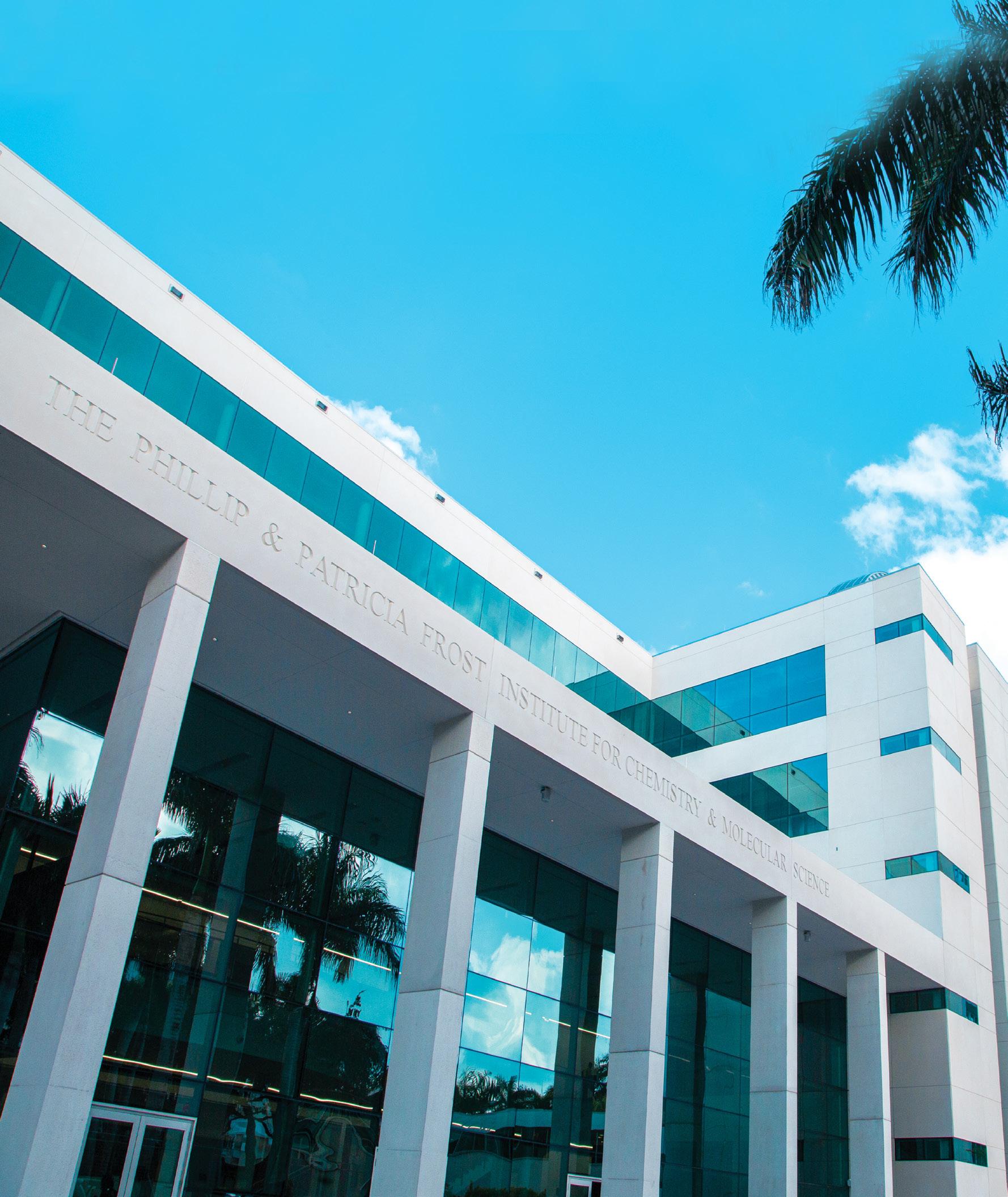
“This Frost Institute will enable the University of Miami to elevate our research capabilities and delve into projects at the forefront of the chemistry, molecular science, environmental and biomedical fields, and ultimately, to translate ideas into important global solutions,” says Jeffrey Duerk, executive vice president for academic affairs and provost “Since chemistry and molecular science are critical to the foundation for so many other fields, we hope that faculty and students across the U will take advantage of this incredible resource ”
The highly specialized, 94,000-square-foot facility will focus on research at the molecular level, often invisible to the human eye without microscopes But by examining cells and particles at such tiny scales, researchers can learn more about their structure and experiment with treatments for diseases and illnesses This is a crucial step in the development of novel medical treatments and therapeutics, says Dr . Mark Yeager, the institute’s executive director .
The building’s labs will also enable scientists to examine metals and alloys at the molecular level to develop, for example, new computer chips, or batteries for electric cars, Yeager notes .
“Students really want to make their work relevant and have it impact the human condition, and I feel the same way,” says Yeager, who is also a cardiologist and professor of chemistry, biochemistry, and molecular biology “I love science, but it manifests so much more meaning if you see how it can help people improve their lives . ”
Before coming to the U, Yeager led the University of Virginia School of Medicine’s Department of Molecular Physiology and Biological Physics for 11 years and helped establish the Sheridan G . Snyder Translational Research Building . Throughout his career, Yeager learned the power of collaboration, and he says the Frost Institute will spur more research across disciplines .
“People often refer to the problem of silos, where traditional departments like chemistry, physics, and medicine are insular, when in fact there could be a lot of synergism,” Yeager says . “The idea of the Frost Institute is that it will become a driver of this synergy and provide the opportunity to align scientists and clinicians pursuing the same areas to work together . It will integrate all the expertise to solve unmet clinical needs and environmental problems . ”
Yeager does not want to attract just faculty members, though The entire building is designed to engage the University and larger community in its research . With floor-to-ceiling windows and a massive screen hanging in the lobby, passersby will be able to see video feeds of ongoing research inside the shared Molecular Electron Microscopy Center . The state-of-the-art lab will eventually have five specialized, leading-edge microscopes enabling visualization from atoms to cells, that anyone in the University can utilize .
“It was part of the design to put it at the crossroads of student traffic on campus,” says Leonidas Bachas, dean of the College of Arts and Sciences and a biological and analytical chemist who served as the institute’s interim director . “You can’t miss it, and I hope students will also get excited about what’s happening inside ”
Pratim Biswas, dean of the College of Engineering and a professor of chemical, environmental, and materials engineering, says many of his collaborators are already interested in visiting the facility .
“There’s nothing south of the Oak Ridge National Laboratory in Tennessee that has this type of equipment for molecular science,” says Biswas, who is moving his aerosol and air quality lab to the third floor . “It is a state-of-the-art facility built to do some unique research And it will become the pride of the University so that researchers will come to us ”
All the laboratories also have an open design to encourage communication and cooperation And throughout each floor, there are communal conference rooms and huddle rooms, where students and researchers can discuss experiments, says Jessica Brumley, vice president of facilities operations and planning at the University
“This is a new way of building research facilities so that the flow of ideas is not impeded and researchers can move easily from one bench to another,” Bachas adds
While the first three floors are ready for occupants, Yeager is actively looking to hire additional faculty members He will hire more as the fourth and fifth floors are completed in early 2024
The first floor features a grand 24-foot ceiling that reaches the top of the second floor, an open seminar room with a display lab, and a large great hall . In the shared Molecular Electron Microscopy Center, researchers will be able to examine the atomic structure of hard materials such as metal alloys . Several of the instruments also will be able to apply the technique of cryoEM, where sensitive biological samples, like proteins and molecular complexes, are flash-frozen and studied . These images provide deeper insight into human physiology, which is critical for drug discovery
The second floor will house Yeager’s lab and other scientists working on molecular drug design . For most of Yeager’s research, he uses cryoEM This method inspired his previous research on gap junction channels . These channels stimulate cooperation and signaling between the body’s cells . They are particularly important in the heart, where these channels help maintain a normal heartbeat . By analyzing them, Yeager was able to reveal some of the cellular changes that occur during a heart attack, but he has also used cryoEM to study how HIV-1—the virus that causes AIDS—can enter host cells, replicate, and assemble infectious particles .
The third floor will be devoted to aerosol sciences, which examine the formation, transportation, and synthesis of particles from their molecular constituents Today, the field is considered part of nanotechnology, a new branch of chemistry where scientists manipulate individual atoms and molecules to create new medical therapeutics and novel materials, as well as innovative energy and environmental technologies .
Now, after more than two years of construction, University
leaders are eager to see the Frost Institute become a hive of innovation
“Our hope is that 10 years from now we’ll be looking back and saying this major drug was discovered here because we had the right people, technology, and the right collaborative attitude,” Bachas says “Hopefully, the Frost Institute will become a catalyst for major discoveries that happen on our campus and that can somehow be helpful to the world ”

“This is a crucial step in the development of novel medical treatments and therapeutics.”
—Mark Yeager
The Florida Everglades fascinates, captivates, and calls to University of Miami scientists who venture into Everglades National Park—which is celebrating its 75th anniversary—to protect this extraordinary ecosystem.
 BY MICHAEL R. MALONE
BY MICHAEL R. MALONE
tranquil in its quiet beauty, serving not as the source of water, but as the last receiver of it. To its natural abundance we owe the spectacular plant and animal life that distinguishes this place from all others in our country.”
6, 1947
AS HE SQUELCHES THROUGH THE SWAMP, HUNTER HOWELL KEEPS HIS EYES PEELED AND SENSES KEENLY TUNED. HOWELL IS TRACKING SALAMANDERS— ESPECIALLY GREATER SIRENS AND TWO-TOED AMPHIUMAS—AND AS HE SLOGS THROUGH THE WATER HE’S SCANNING ITS DEPTH AND COLORATION FOR SIGNS THAT THESE SLINKY, SOMETIMES HUGE AQUATIC CREATURES ARE NEARBY.
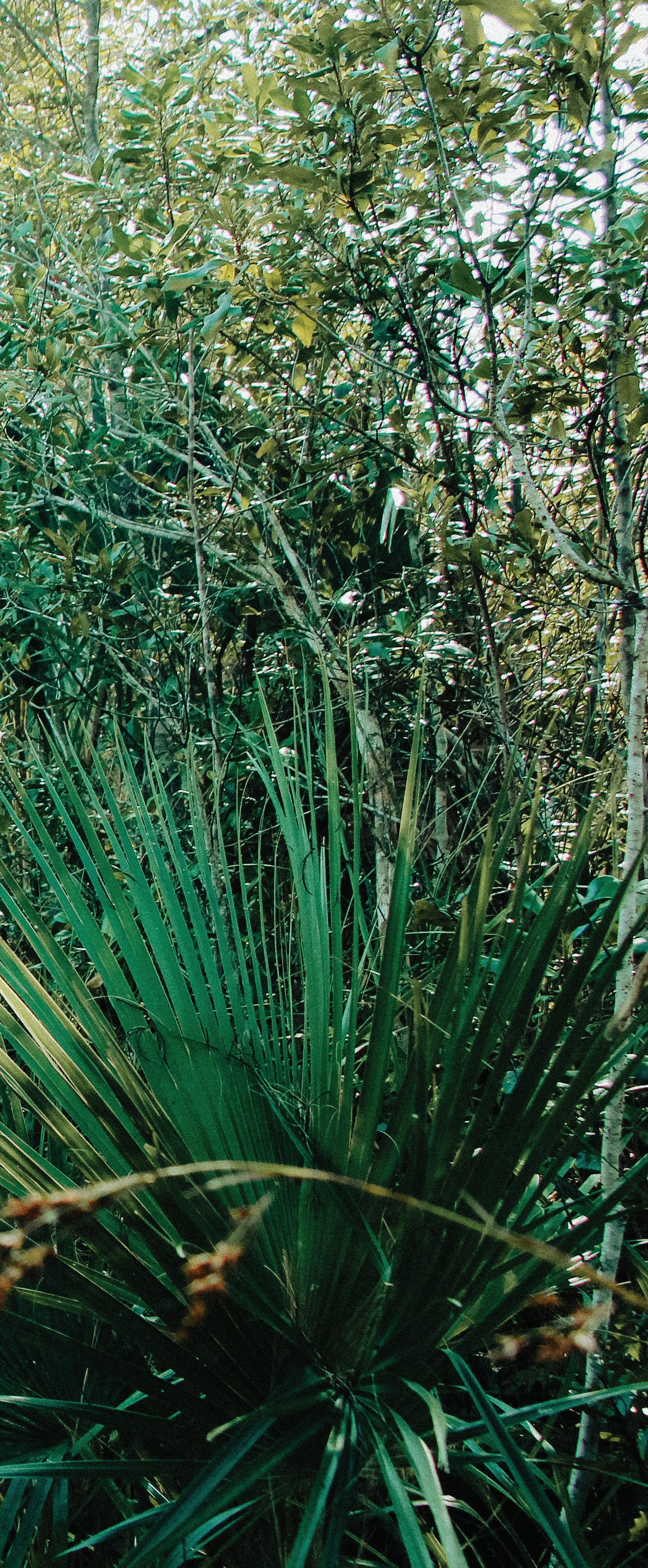
OtherFrom the visual variations in water and soil, Howell deciphers the type of vegetation and the thickness of the muck, all clues to knowing where to spot these particular salamanders, a main focus of his research in the Everglades—the vast, unique South Florida ecosystem that has been his classroom since he arrived at the University.
“You just got to be out there practicing; it’s just like everything else,” says Howell. “You start to get a sense of where the salamanders like to be and where your traps can be the most effective. It’s all about being out there.”
“Here is land,
And Howell has been “out there” a lot as part of his studies . He’s scheduled to receive his doctorate next spring, and that diploma will represent a unique and extraordinarily valuable skill set and knowledge base . Howell has spent 10 consecutive years in college, the past six at the University where, buoyed by the prestigious Dean’s Fellowship, National Science Foundation graduate research fellowship, and other grants, he has advanced his life’s calling as a conservation biologist .
On a recent Sunday morning this fall, Howell was in his habitat—the Big Cypress National Preserve . Birds arced and glided in the azure sky above, and alligators lounged close by in the fenced canal He wore a green University “Grad Student” T-shirt, donned a Kings Canyon National Park 1940 cap, and shared his fascination with the Everglades .
“There’s no other place like this in the world,” he says “I just really like getting out here . Even when I’m not working during the winter, I’m normally out camping, either at Flamingo or over on Bear Island and going for hikes, cruising at night trying to catch snakes, doing wildlife photography, invasive species removal— whatever,” he adds . “I’ve just fallen in love with the place and consider it a great honor, honestly, to be able to work on protecting it and to be a piece of the puzzle that works on understanding and protecting this place . ”
Howell is a herpetologist, a person who studies reptiles and amphibians or, as he says, “I study creepy, crawly things.”
His inclination to protect and understand the natural world began early . He grew up near Baltimore, Maryland, and developed an early awe and affinity for the spotted turtle .
“It’s an amazing, completely armored animal unique in its defensive structure,” explains Howell . “As part of their evolutionary history, the shoulder girdle has shifted inside their rib cage skeletal structure, and their effective life history strategy has allowed them to outlive the dinosaur . ”
By sixth grade he was excelling in life sciences and biology and closely tracking the exploits of Steve Irwin, the acclaimed Australian zookeeper, conservationist, and wildlife expert, on the television series, “The Crocodile Hunter . ”
“I loved his ethos—he really just wanted to save the world— to make as much money as possible to buy land to conserve it to protect wildlife,” recalls Howell, admitting that he began to see himself as a wildlife “Hunter” as well He found inspiration, too, when he read Aldo Leopold’s classic “A Sand County Almanac” in middle school .
Howell went on to attend Towson College, majored in biology with a focus on organismal ecology, and earned his B A —the first in his family to earn a college degree . The opportunity to continue his studies at the University of Miami offered thrilling possibilities
He visited Miami and met with Chris Searcy, an associate biology professor in the College of Arts and Sciences . Searcy would become his advisor and mentor .
Howell has a vivid recollection of his first visit to the Everglades, Marjorie Stoneman Douglas’ celebrated “River of Grass,” an environmental wonder he had only imagined up to then .
“It was a crisp clear day in January, and we were on the Anhinga Trail I had never seen a wood stork in the wild, and it had always been my dream to see one—and there it was . It was so cool, and then to see the softshell turtles swimming through the water and alligators basking everywhere It was incredibly impressive in the middle of winter to see all that diversity,” Howell notes .
His research focuses broadly on understanding what’s happening with the reptiles and amphibians and how management practices are impacting them Ultimately, together with Searcy and colleagues, the team will provide recommendations to the South Florida Water Management District (SFWMD) and Everglades National Park with the aim of conserving those species in the future .
The research has three major focus areas First, Howell is analyzing long-term data sets to see what has changed and to assess the cause . He has compared data from two sets for the period 1996-2019 and determined there’s been roughly a 75 percent decline in the Everglades’ amphibian abundances
Second, since 2018, he has been working on the grounds of the Arthur R . Marshall Loxahatchee National Wildlife Refuge, specifically at the Loxahatchee Impoundment Landscape Assessment (LILA), an 80-hectare landscape model and living laboratory for Everglades restoration near Boynton Beach, Florida . By implementing management strategies in a controlled area—such as changing the hydrological regime or the amount of water flow through the ecosystem—the team is trying to figure out how that’s impacting the community composition Together with other scientists such as Eric Kline of SFWMD and Mark Cook, LILA’s scientific director, they’re conducting invasive species removal to assess whether the impact is positive and worthwhile
The largest and most recent component has been the focus on understanding the natural history of the giant aquatic salamanders—their diet, population dynamics, and home ranges—and then updating the Everglades energy flow model with the new information about those species .
Sirens and the amphiumas are some of the largest extant amphibians in the world, yet Howell is aware of only one study on the latter and none on the sirens within the Everglades ecosystem .
“We’d been catching a lot of them at the study site, and knowing that they were understudied really inspired us to study them,” he points out . “Our estimates are that their densities are five to six times what we originally thought ”
That abundance may be critical The sirens primarily eat apple snails, and the amphiumas primarily eat crayfish, which means they’re eating the same food sources as wading birds—a principle focus of Everglades conservation
His team has yet to determine whether the competition for the food source is impacting the wading birds . Howell highlights the nuanced interdependences ever present in the ecosystem
“There could be just so many snails, so many crayfish, that the limiting factor is not that the salamanders are eating too many crayfish, but instead it’s that the ibises just can’t find enough of

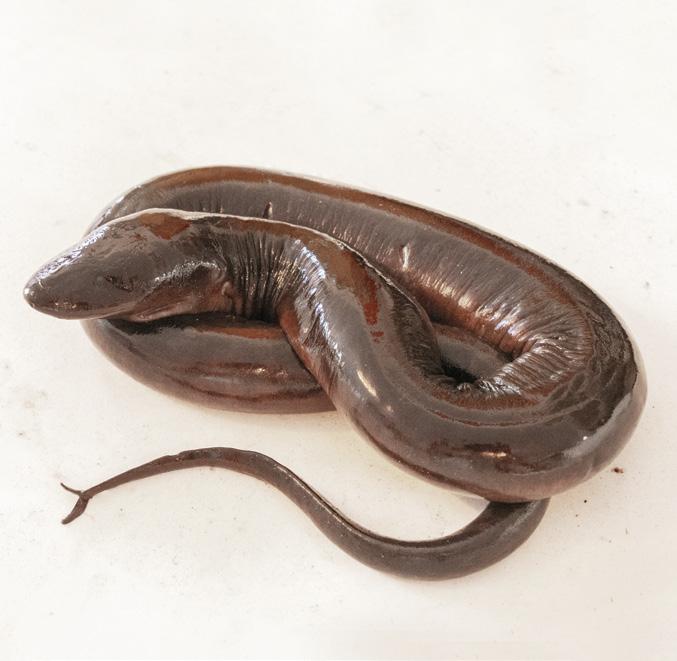








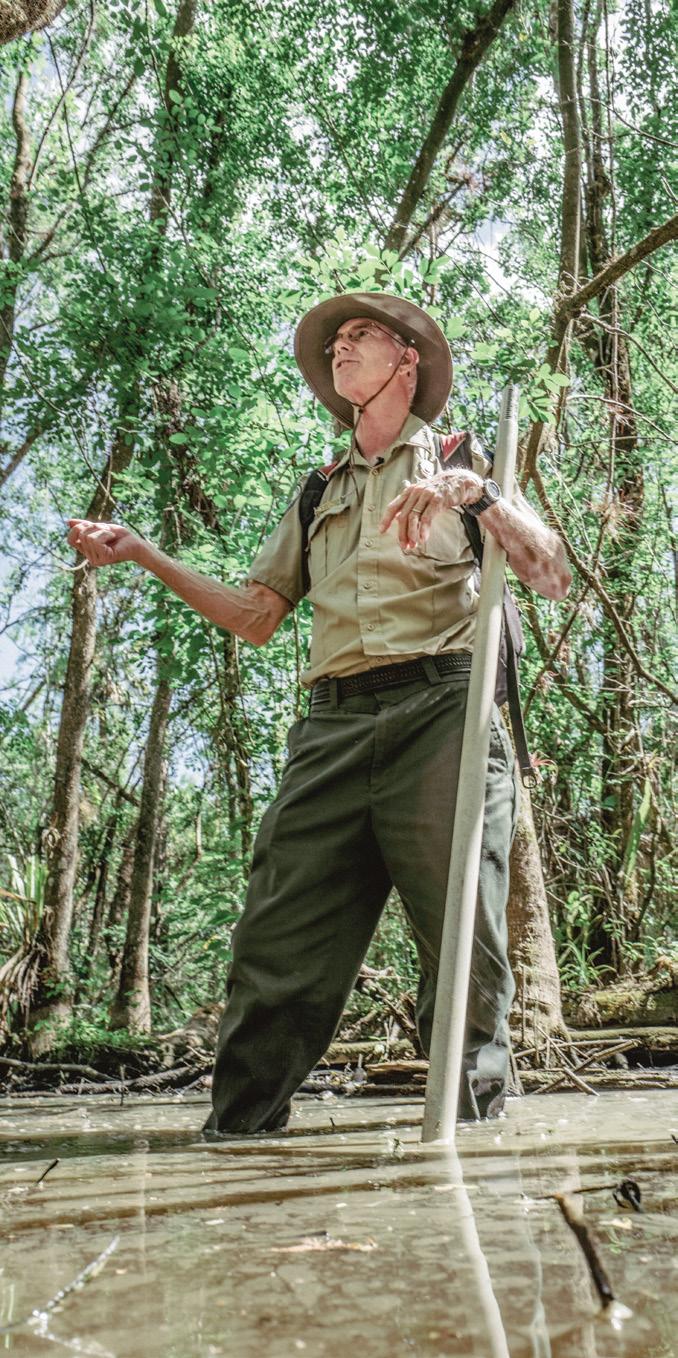

them fast enough to keep eating them We just don’t know yet,” the herpetologist explains .

Studies such as Howell’s require incredible diligence and no small degree of inconvenience
One study spanned 10 weeks and required four weeks from mid-July to mid-August of consecutive workdays for field visits . Up at 5 a m , to the lab by 5:30 a m , then either a drive to the airport to catch a helicopter or travel by airboat or canoe to get to any one of 30 different research sites spread across the entirety of the 1 5 million acres of the slow-moving swamp—60 miles wide and 100 miles long—to check the traps and log the readings, then on to the next site until afternoon and then make the trip back home .
Despite delays with travel and getting funds administered, complicated logistics and transport, and hours on site in the sweltering summer heat, the experience was wondrous .
“I didn’t really think that I’d ever get to do that kind of work because it’s very logistically challenging,” says Howell, pointing out that because management of the Everglades is divided—SFWMD manages the water conservation areas, and the Department of Interior manages Everglades National Park—research is often siloed . Few biologists get the experience he did .
“ It was tons of work, but very, very cool getting to see the entire Everglades ecosystem from top to bottom,” Howell says.
“All the way south of Lake Okeechobee to the top of Loxahatchee National Wildlife Refuge, down to basically where the mangroves start . It was a huge area to cover . ”
Howell is excited to pass the research baton on to a protégé, a new Ph D student partner who has joined the research team
“I wish I could just do a brain dump and transfer my brain files over to him instead of him having to go through it all,” says Howell, then runs through a long list of basic stuff—annual samplings that must be done the same way to keep the data consistent and comparable, skills on how to pick and tag, radio tracking, and implants with the polymers “It’s complicated, but easy enough to teach . ”
Howell is especially proud of the salamander research—the largest ever conducted—and hopes those studies will continue He emphasizes the collaborative inroads made with SFWMD and LILA and says the decisions about what will be studied going forward and new planning goals will be decided at the upcoming stakeholder meeting that involves professors Searcy and Michelle Afkhami, who has been working with students in the Everglades since 2018, and other biologists
After 10 straight years of college, Howell is “very, very ready” to graduate and move on in his career . He and his romantic partner, a specialist in emergency medicine—the two bonded over a discussion about venomous snakes—will soon learn the location of her medical residency, and the two will travel wherever she’s assigned Howell will explore optimum opportunities for his ophiophilist instincts .
Given what he has learned, as he looks to the horizon, does he feel hopeful for the Everglades as an ecosystem?
“Being a conservation biologist is a very depressing field, especially right now,” Howell answers .
He references a restudy of his favorite spotted turtles that compared two periods 1986-1993 with 2014-2017 The results followed the same trend as that of the study on amphibians: a 50-percent decline in the abundances of the turtles . Howell points to increased development that brings road mortality and mesopredators—raccoons, skunks, feral cats, and all those things that predate nests and juvenile turtles—as the major culprit .
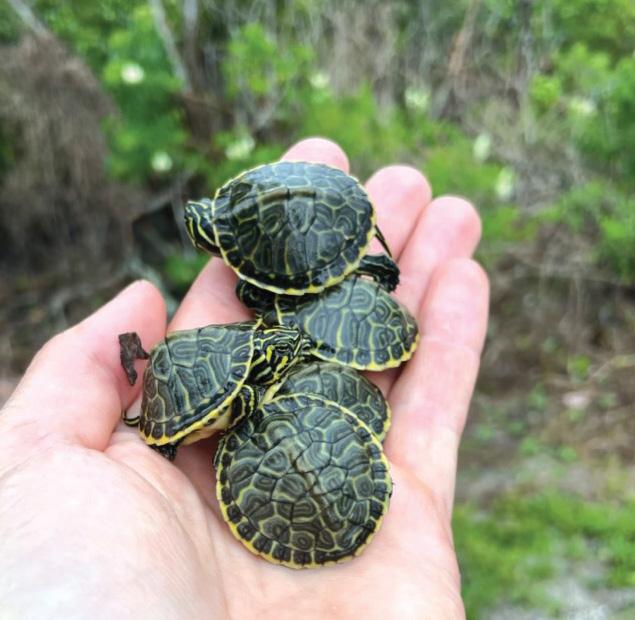
“Yet the work in the Everglades is definitely encouraging—it’s the largest and most expensive restoration project in the whole world ever initiated,” Howell says . “So, the fact that just enough people care enough and that Congress is spending money here is really good . ”
He highlights the regrowth in bird populations, noting that the numbers of wading birds, waterfowl, ducks, and others are at historical values .


“There’s a huge amount of effort put into conserving those populations, so that they can exist in the future,” he says “Yet that shows you that when you have targeted management actions, it works, and we can restore these populations . We have evidence that that’s the case ”
Howell highlights the juxtaposition that some species are rebounding while overall the scenario remains bleak .
“There’s a lot of Everglades restoration work I’m involved in that shows reason to be optimistic about certain populations, but in general a lot of things are declining quite rapidly in front of our eyes . We don’t seem to be doing as much as we need to, to prevent that from happening,” he notes ”
Michelle Afkhami, associate professor of biology, studies the interactions between plants and microbiomes in the soil that often help plants and trees grow . For the past two years, her research in collaboration with the South Florida Water Management District (SFWMD) seeks to learn how microbiomes and hydrological management impact the growth of tree islands, one of nine ecosystems in the Everglades .
“Tree islands are nutrient hotspots, so they are important for other fauna such as alligators and other plants and animals native to this region They make up a small part of the Everglades but are very important for ecosystem function if we want to really restore the Everglades,” she says .
Afkhami and her students care for these trees in the University’s greenhouse to understand the stability of each species and how they react to varying amounts of water They also assess soil samples, sequence the genes of the microbes in the lab, and compare them to the soil microbiomes of artificially constructed tree islands within an 80-hectare experimental landscape in the Everglades . Results are shared every six months with SFWMD to support efforts to conserve the vital biological heritage of the region .
Traci Ardren, professor of anthropology, is researching the evidence of sustained pre-Columbian human occupation and socio-ecological interaction within Everglades National Park Utilizing archaeological data on dietary and cultural patterns recovered at a prehistoric tree island site, her collaborative research team is exploring the role of ancient human populations in the formation or augmentation of tree islands, one of the Everglades’ distinct ecosystems
The collaborative effort between environmental scientists and archaeologists seeks to foster more accurate identification of anthropogenic environmental impacts over time .
Kim Grinfeder, director of the Interactive Media Program in the School of Communication, together with partners in 2018 developed SwampScapes, an awardwinning virtual reality and multiplatform exploration of the Everglades The immersive documentary allows people of all abilities to experience the wonders of the ecosystem without needing to physically visit . A curriculum to accompany the film was created and has been utilized by about 4,000 middle-school students
Along with Rafael Araujo, M .A . ’98, professor in the Rosenstiel School of
Marine, Atmospheric, and Earth Science, and Ruth Ron, from the School of Architecture, Grinfeder developed Mangrove City, an interdisciplinary class that uses computer graphics on a digitalized platform to emulate the experience of living in a tidal community
“Mangrove City aims to teach about the critical importance of the mangroves You paddleboard down canals, stop at different stations along the way to learn to identify different mangroves, match the bird sounds, and experience the tidal wave movement—imagine ‘SwampScapes’ on steroids,” he says .
“In my classes, there is no right or wrong answer—it’s how good your argument can be, how fact-based and well-founded you can argue It’s not a math question; it’s not just science . It’s trying to figure out the best solution for an ever-evolving and changing world ”
Marc Knecht, professor and chair of the Department of Chemistry, in collaboration with Leonidas Bachas, dean of the College of Arts and Sciences, leads a team that studies how chemical reactions can be used to clean pollutants from Everglades water systems .

Their research uses nano materials activated by sunlight to drive the degradations
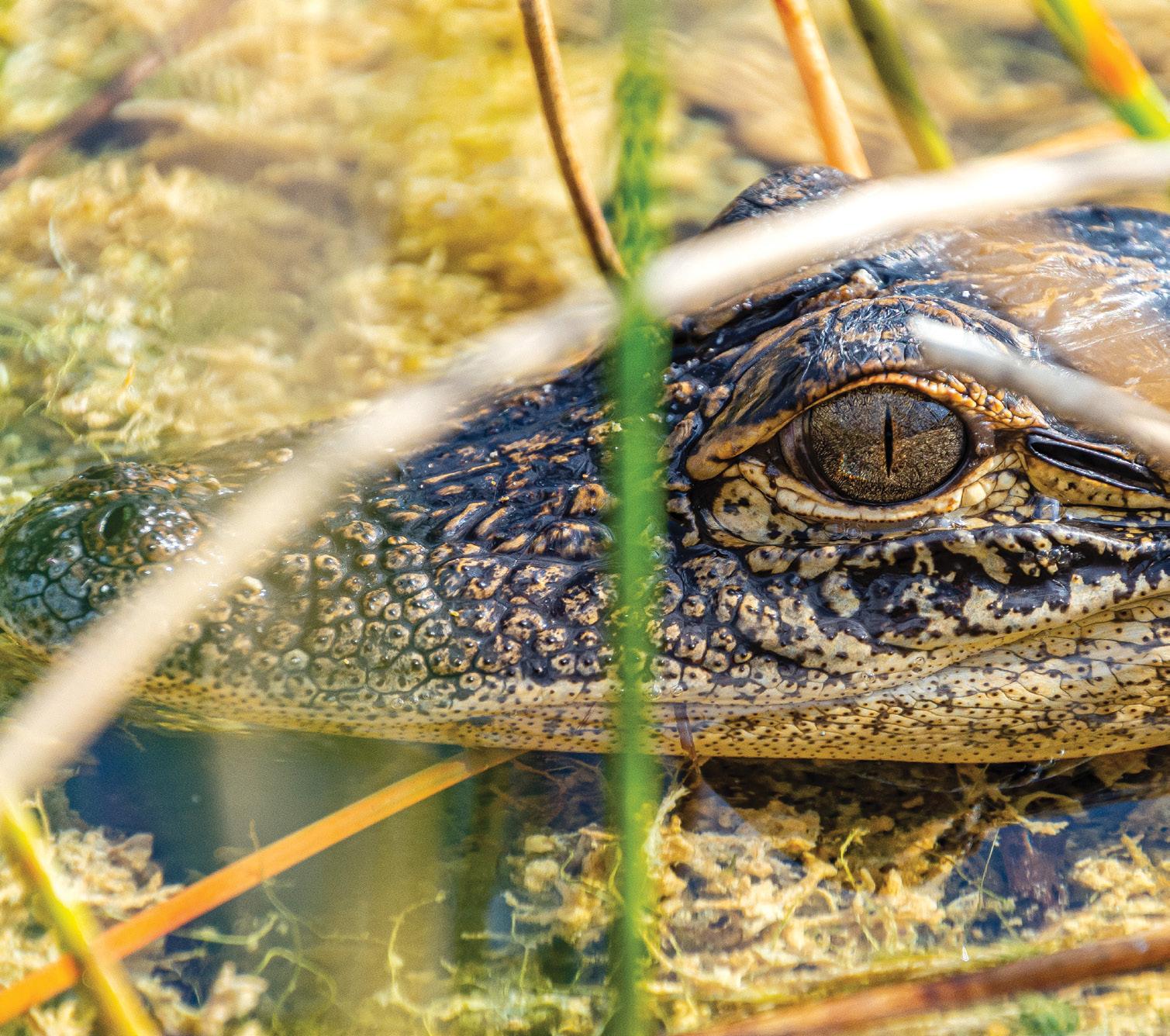
of pollutants—organic molecules, pesticides, flame retardants, etc .—that are released into the Everglades
The team will be submitting a paper that documents some of their most surprising findings of how the nanoparticles, based on the catalyst, prompt a variety of intermediate chemical structures .
Chris Searcy, associate professor in the Department of Biology, is a conservation biologist who has been researching the Everglades since he arrived in Miami in 2016 .
His initial involvement focused on a collaborative experimental landscape project that replicated all elements of the Everglades system . Using a giant pump to manipulate water flow through determined cells, the team could assess for optimum hydrologic conditions . The landscape model has driven a range of other projects and advanced the efficacy of the restoration effort .
With herpetologist Hunter Howell on the team, they’ve expanded research of amphibian trends to better understand their impact on the Everglades food web
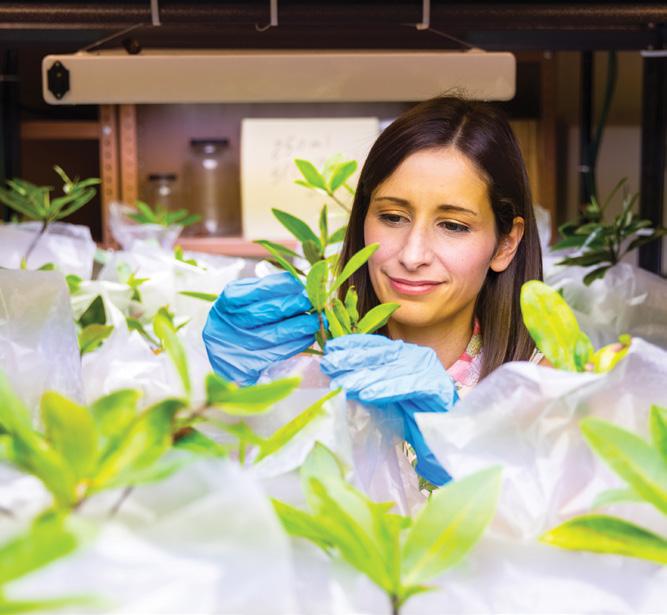
“I’m personally an amphibian and reptile biologist, so those are unexplored areas that were of interest to me There are other things that remain to be discovered about the Everglades, and we just need to keep understanding it better It’s no longer a natural system—humans have put themselves in charge of the Everglades . So now that we’re in charge of it, we need to do it right,” Searcy notes
Harold Wanless, professor in the Department of Geography and Sustainable Development, has researched changes in the Everglades since the 1960s relating to salt-water intrusion and the collapse of wetlands because of storm events and sea-level rise .
In the aftermath of Hurricane Andrew in 1992, his research team accessed NOAA photographs from the 1920s that established a baseline for hurricane damage to coastal mangroves, which have deep root
systems that are ideal for capturing carbon and removing it from the atmosphere .
“A lot of the mangrove coast has been losing out to erosion When salt water gets into mangroves, the fresh water wetlands dies and decays, and the soil collapses and it turns to open water One of the focuses of the past decade was trying to get places like Everglades National Park to actively encourage the regrowth of mangroves, which sometimes takes a little redoing of the plumbing to get good water to circulate,” Wanless points out .
Richard Weisskoff, professor and chair of the Department of International Studies, has developed an expertise for economic modeling and policy analysis that has been applied for a range of environmental elements—coral reefs, beaches, forests, recreational and industrial parks, and farmland—around the world . In South Florida, he applied his models to water from the Everglades as a vital resource for South Florida .
“I wanted to model the entire region of the Everglades by mapping it out and watching it grow over the next 30 years, and then find out if there would be enough water to support Everglades restoration as well as the future population,” he explains .
Kelly Cox, J .D ./M .P .S . ’16, environmental attorney and advocate, is the director of Everglades Policy for the National Audubon Society and a lecturer at the Rosenstiel School since 2017, where she teaches environmental law and fish and wildlife law
With Audubon, Cox focuses on advancing the comprehensive Everglades Restoration Plan, the framework built in the 1990s of some 60 different projects that are to be completed within a 30-year timeline
“We have a playbook, and getting those projects funded and making sure they’re working the way they were intended is my top priority . ”
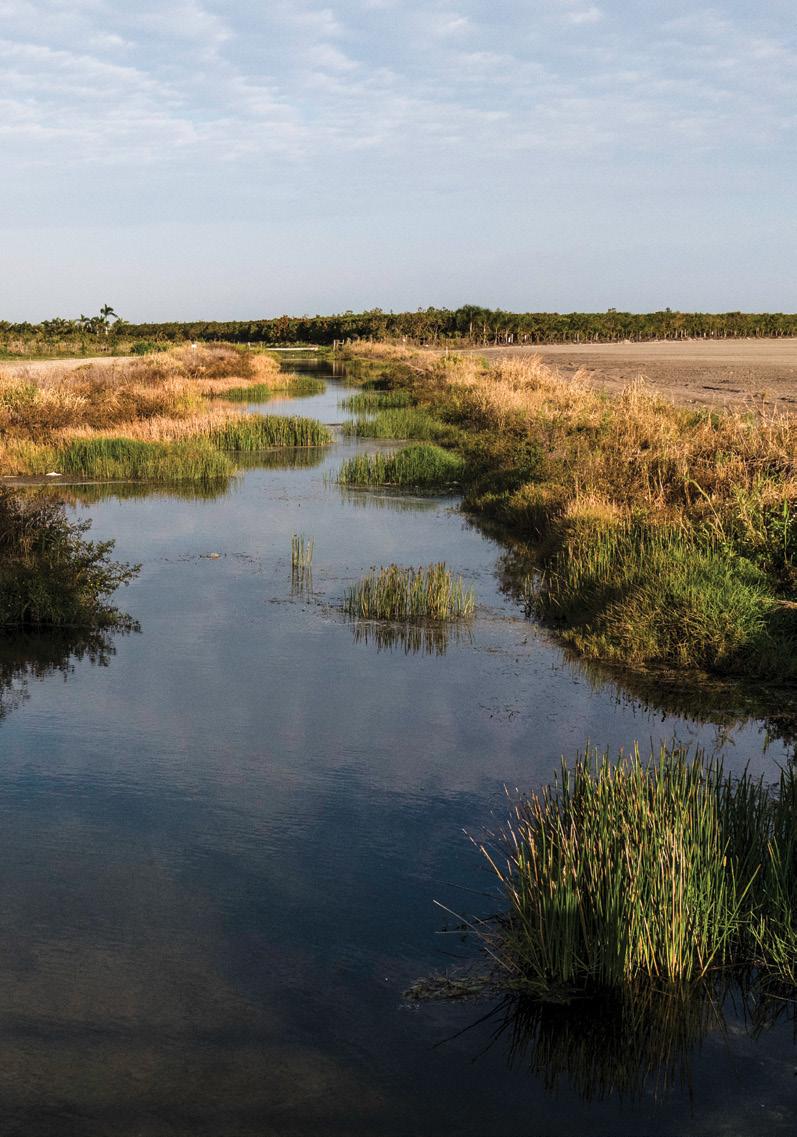
“It’s trying to figure out the best solution for an ever evolving and changing world.”Michelle Afkhami studies the interactions between plants and microbiomes in the soil that often help plants and trees grow.
Enabled by an innovative technology developed by doctors at The Miami Project to Cure Paralysis, a young man paralyzed in a car accident uses his thoughts to exercise basic physical movements and even to drive a race car.
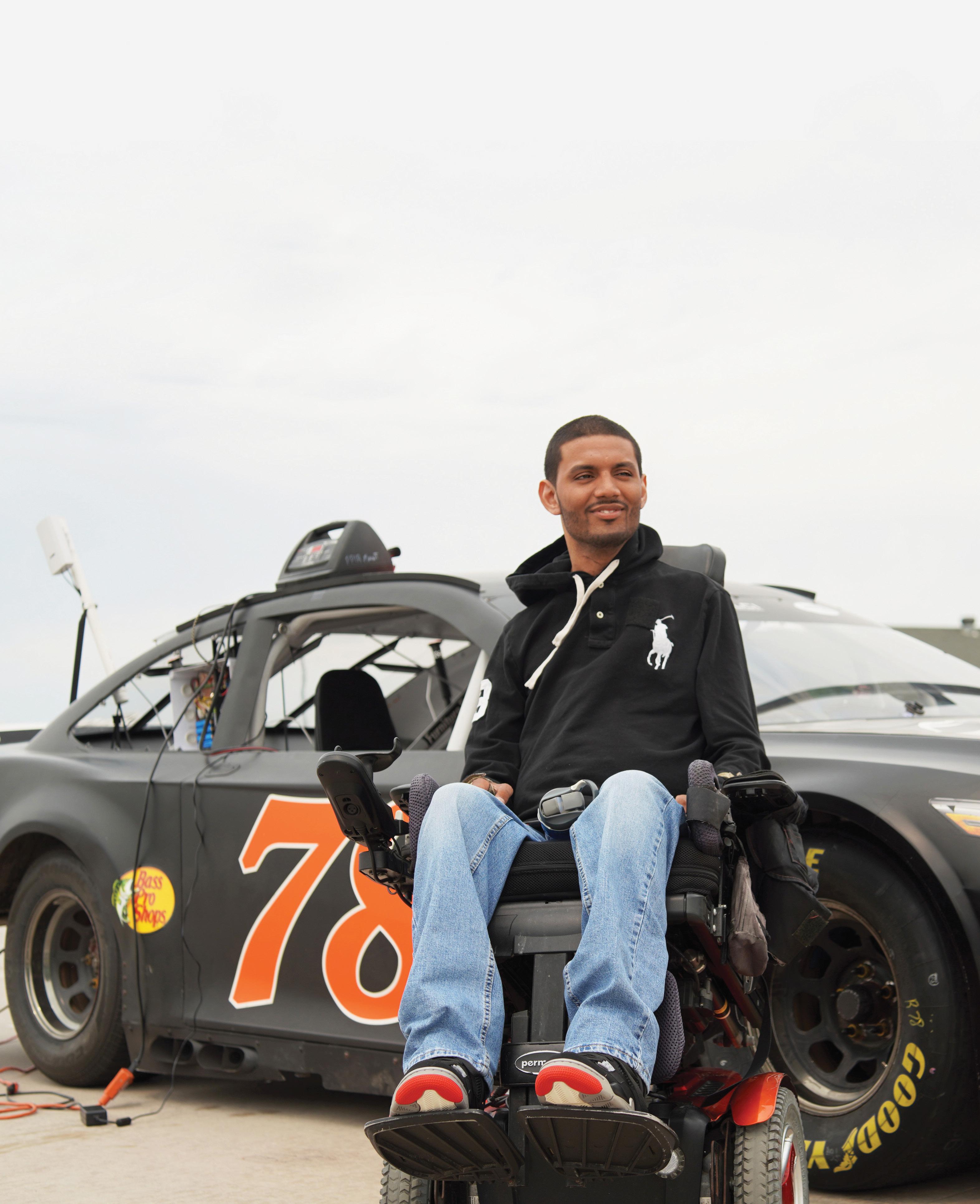
GERMAN ALDANA ZUNIGA LOST BOTH LEGS AND WAS LEFT PARALYZED FROM A CAR ACCIDENT IN 2013. HE WAS JUST 16, AND DOCTORS TOLD HIM HE WOULD NEVER BE ABLE TO WALK OR USE HIS ARMS PROPERLY AGAIN. YET ZUNIGA HELD ONTO HOPE THAT SOMETHING OR SOMEONE MIGHT SHIFT THAT PROGNOSIS.
Nine years later, Zuniga is back behind the wheel of his life . With the help of a surgically implanted brain-computer interface (BCI) that can decipher his thoughts, Zuniga recently drove an adapted NASCAR race car around Pikes Peak International Raceway in Colorado, just by thinking about grasping the accelerator

He’s also able to connect his BCI to an adaptive glove each day to help him regain some control of his right hand to open doors, feed himself, write short notes, and brush his teeth .
Zuniga’s new lease on life is thanks to an ingenious technology developed by doctors at The Miami Project to Cure Paralysis, a center of excellence at the University of Miami Miller School of Medicine
After his accident, Zuniga spent six months in the hospital and a year in rehabilitation while working to complete his junior year of high school . From other survivors of spinal cord injuries, he learned the importance of staying active to prevent more muscle spasms or atrophy One day, while exercising in the gym of The Miami Project and participating in other clinical trials, he noticed a newsletter ad about a study recruiting people with spinal cord injuries to volunteer for a BCI implant .
Zuniga applied, met the strict qualification criteria, and once he turned 21, went in for surgery
The procedure marked the first time that doctors at The Miami Project had implanted a BCI solely for research purposes, according to David McMillan, Ph D ’20, director of education and outreach for The Miami Project, as well as an assistant professor of neurological surgery at the Miller School
“Finding someone brave enough to get a brain implant when they don’t need it was tricky,” says McMillan . “There was no guaranteed benefit, but German’s courage and exploratory spirit were amazing ”
Two weeks after his surgery, Zuniga met with the research team, which includes study leader Abhishek Prasad, a biomedical engineering associate professor; Dr Jonathan Jagid, professor of clinical neurosurgery; Dr . Michael Ivan, associate professor of neurosurgery; Dr Iahn Cajigas, a former neurosurgery resident; and Kevin Davis, a graduate student in Prasad’s neural interfaces lab at The Miami Project .
With the BCI in place, Davis, Prasad, and others designed software to decode Zuniga’s brain signals from the device . They asked him to think about opening and closing his hand, then trained the BCI to pick up those unique signals from the part of the brain responsible for moving his right
German Aldana Zuniga uses his adaptive glove and brain-computer interface (BCI) to grasp a permanent marker.

hand . In time, their work allowed Zuniga to not only control the glove, but also to use his BCI to control a robotic walking device on a treadmill at The Miami Project Davis—a self-taught software engineer who studied neuroscience in college—then figured out how to make the decoder portable so Zuniga could use the BCI out of the lab Davis even developed a cell phone app that connects to the BCI via Bluetooth and prompts Zuniga to think about opening and closing his hand Then, a minicomputer in Zuniga’s backpack connects his brain signals to control a device—typically the adaptive glove .
“The BCI extracts the data from the brain, and then it sends information to another device like the glove, or in the most recent case, a car accelerator,” explains Davis, a student in the M D /Ph D Medical Scientist Training Program
Just before the COVID-19 pandemic began, Davis finished refining the portable BCI decoder . This was particularly fortuitous because Zuniga could practice his new skills at home throughout the past two years, and Davis could refine the software remotely when needed . He is also able to collect data on Zuniga from home now and is gathering evidence about how useful the BCI setup could be for others with spinal cord injuries .
Jagid notes that Zuniga is the only person with a spinal cord injury he knows of with this mobile setup Other BCI patients typically have a visible device protruding from their head and must be in a lab to connect it to a machine that decodes their brain signals
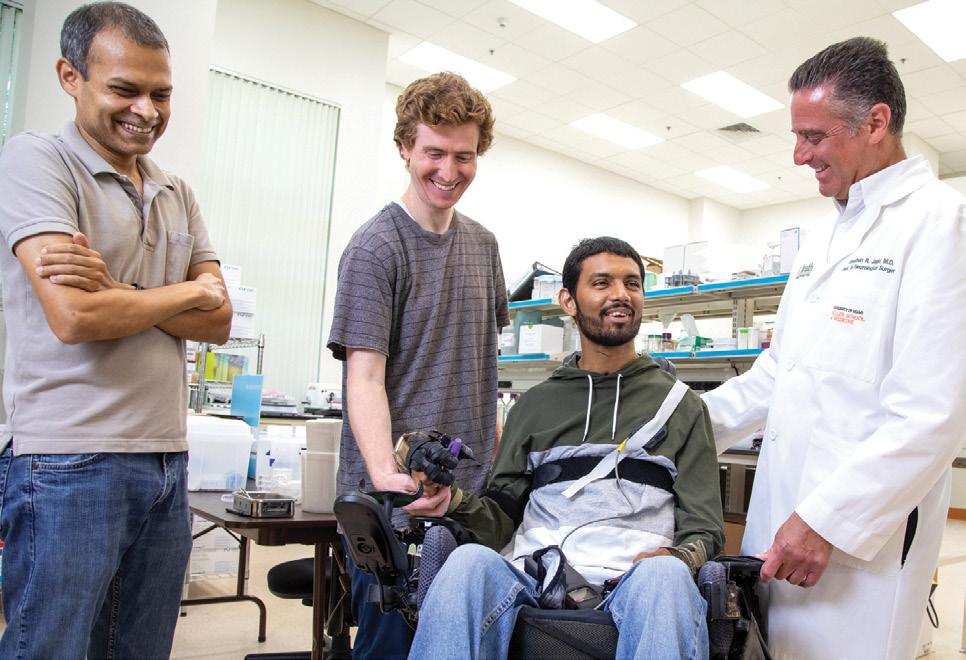
There are myriad benefits to the flexibility of Zuniga’s transportable BCI, McMillan adds .
“Other people may have BCIs with a wider signal that can send more advanced commands [from their brain], but because this one is simpler, it allows German to use it in a variety of contexts,” McMillan says “He is using it to do simple activities of daily living, and to control really advanced robotics, like an 850-horsepower NASCAR race car .”
This spring, Falci Adaptive Motorsports and its founder Dr Scott Falci, a neurosurgeon based at Craig Hospital in Denver, Colorado, offered Zuniga a special opportunity: to drive one of their adapted race cars . At the time of his accident, Zuniga had yet to obtain his license—and it had been a longtime dream of his to do so .
Falci had developed a vehicle that allows a driver to speed up or slow down by blowing or sipping air through a straw, and steer using a helmet equipped with a gyrometer . Davis’ team adapted the technology, substituting the existing system for one that controlled the car using Zuniga’s thoughts
Davis and the rest of the team flew with Zuniga to Denver and drove down to Colorado Springs in an adaptive van .
“We trained a handful of times before we left, but German was still just using the same motor imagery of opening and closing his hand, which he’s quite familiar with,” Davis explains “He just needed to figure out the sensitivity of it to apply to the gas ”
While there was a safety driver in the car with him, Zuniga was exhilarated by the experience of driving a race car

“To see how I was able to control a car—it’s something I never would’ve thought that this device could make possible ”
The next step for the team is to expand the applications of Zuniga’s currently implanted BCI by trying to extract more unique signals from his brain This could allow for more complex function, such as the use of both hands At the same time, the team is researching other braincomputer interfaces that may allow future patients to have more freedom and restoration of function
Zuniga had always hoped to attend college after graduating from high school in 2015 . After experiencing the power of technology, he decided to become a computer science major at Miami-Dade College and now hopes he can program brain devices to help other people like himself gain mobility
“Working with the BCI sparked an interest in me because I saw what you could do with technology,” Zuniga says “It has given me the hunger to want to help make it better and even to create a new device one day .”
“ After the first lap, I lost my fear and the sense of freedom was amazing ”
—German Aldana ZunigaDAVID MCMILLAN
Long before even the first of Hurricane Ian’s 140-mile-per-hour winds and torrential rains began to pummel the west Florida coast in late September, the University of Miami was fast at work preparing its facilities and working to safeguard personnel who might be in harm’s way of the storm.
 BY MICHAEL R. MALONE
BY MICHAEL R. MALONE
WITH A CLOSE EYE ON IAN’S APPROACH, THE UNIVERSITY ISSUED A SERIES OF ADVISORIES AND NOTIFICATIONS OF PREPARATIONS AND OPERATIONAL CHANGES FOR CLASSES, EVENTS, AND CLINICAL ACTIVITIES. IN-PERSON CLASSES ON THE MARINE AND GABLES CAMPUSES WERE SUSPENDED ON THE AFTERNOON OF SEPT. 27 AND REMAINED CLOSED ON SEPT. 28.
As soon as campuses were deemed safe, the University resumed operations and moved to mobilize resources and outreach to the ’Canes family, communities, and sister educational institutions across the devastated western coast to launch the long and challenging process of rescue and recovery .
“In the immediate aftermath, it is difficult to know how many have been affected and to what degree, but as ’Canes fueled by a mission of service, we are determined to provide hope and take action during this critical time,” stated President Frenk in one of his multiple storm-associated messages .
The University’s Bascom Palmer Eye Institute in Naples was an area of immediate concern The storm prompted three days of closure, but the facilities suffered no physical damage, and there were no reports of personal injury to employees .
“It was a tough storm—and together with Hurricane Irma, two tough storms—but this is a terrific building and we’re very happy with our facility,” says Dr . Stephen Schwartz, the institute’s medical director “The University was very diligent in helping us get up and running because we know how important it is to keep the wheels turning .”
With seven full-time faculty members and approximately 75 staff, the institute attends to about 150 patients daily and is the only academic medical facility servicing Collier and Lee counties
Schwartz highlights that Hurricane Irma caused longer interruptions because of power outages that led to contaminated water and other complications “We learned a lot from that experience and made some important improvements to our operations,” he says .
According to Schwartz, who lives close to the institute, only one staff member suffered severe damage to her home, while other employees were recovering from moderate home damage along with the loss of vehicles
Bascom Palmer resumed services, both clinical and academic, on the Monday following the storm and prioritized patients who required surgeries or special care . “We tried to make sure that everyone who needed to get in, got in, and I think we were successful,” Schwartz says .
Outreach to ’Canes alumni in Orlando, Tampa, Sarasota, and across Southwest Florida began immediately after the storm to assess for any needs or special support .
On the Coral Gables, Marine, and Medical campuses, students and faculty and staff members with family or friends in
the devastated areas were advised of the many resources available, which included the University Counseling Center, Student Health Service, Faculty and Staff Assistance Program, and others . The Hurricane Ian Emergency Relief Fund was established as a lifeline for those who experienced financial hardship
The University’s Office of Emergency Management partnered with Florida International University and Florida Atlantic University to assist Florida Gulf Coast University in Fort Myers and simultaneously initiated collaboration with State of Florida officials to provide support .
With the recognition that severe weather disproportionately affects people with spinal cord injuries and other disabilities, a multidisciplinary team of University researchers advanced its project funded by the University’s Laboratory for Integrative Knowledge, or U-LINK, that utilizes education, innovation, and outreach to help residents with spinal cord injuries and other disabilities adapt and become more resilient to climate change .
“Anyone can experience a cervical spinal cord injury and find themselves in a wheelchair,” says David McMillan, Ph .D . ’20, research assistant professor of neurological surgery, director of education and outreach at The Miami Project to Cure Paralysis, and the lead investigator of the U-LINK study
The study initially emphasized preparation for climate change . Yet with the urgency prompted by Hurricane Ian, the team looked to expand the U-LINK project to include people with spinal cord injuries who had been impacted by the storm .
Amid the hurricane activity, University researchers continued a range of projects geared to better understand hurricane movement and ultimately to save lives . The University’s tropical cyclone experts play a vital role in helping forecasters to predict the path of storms, flying onboard National Oceanic and Atmospheric Administration (NOAA) Hurricane Hunter aircraft to record critical data on windspeed and direction, central pressure, temperature, and humidity .
African American colleagues and me. The University of Miami and those of us who have benefited from your determination to integrate this faculty and administration are forever in your debt. Your presence at the University has made a difference.”

By the time he was in his late 30s, Whittington Johnson had been a trailblazer in more ways than one. He was the first in his family to earn a college degree. During a two-year stint in the Army Reserve, he was the only Black officer on his base.
In 1970, Johnson, now 91 and retired since 2002, was hired by the University of Miami as the institution’s first Black faculty member. During his 32 years in the Department of History, he realized his ambition to, as he says, “mold minds and create a corpus of knowledge.”
This past August, as the University commemorated the 60th anniversary of its landmark decision to admit its first Black students, Johnson spoke of the student-led protests to integrate faculty members that resulted in his hiring. And he addressed his experiences growing what was then the African American Studies Center.
His remarks were among the highlights of a two-day celebration of UTrailblazers, a decade-long effort of
the University of Miami Black Alumni Society to collect and preserve archival material and memorialize the trailblazers, including Johnson, who broke the color barrier at the institution and fought for racial equality through academic and institutional changes.
The culmination of their efforts to uncover these narratives is preserved in The Taylor Family/UTrailblzers Experience, an interactive display made possible through a generous gift from Johnny C. Taylor, Jr., B.S.C. ’89, vice chair of the University of Miami Board of Trustees. This permanent installation honors the contributions and sacrifices of Black students and faculty members— current and past—who have helped shape the culture and history of the University.
Johnson ended his remarks by thanking Taylor, the Black Alumni Society, and those pioneer Black students for their efforts to seek racial representation among faculty members, saying: “At an earlier period in your lives, your enrollment created an opportunity for my
“At its core, all our efforts have always been about representation,” says Denise Mincey-Mills, B.B.A. ’79, who along with Antonio Junior, B.A. ’79, and Phyllis Tyler, B.B.A. ’79, worked to unearth the stories and struggles of the University’s first Black graduates. “The UTrailblazers [Experience] serves as a monument to the accomplishments of our pioneers and reinforces narratives of success, courage, and scholarship for current and future ’Canes.”
“The University has been profoundly enriched by the contributions of past and current Black scholars,” says President Julio Frenk. “We celebrate the ways our institution has been shaped by your presence, we are grateful for your example, and we strive to create more opportunities for Black scholars to realize their dreams, as you have done.”
The UTrailblazer events also included the Passing of the Baton ceremony, to inspire and embolden the newest generation of Black student leaders at the University, and a gala concert with R&B, gospel, and jazz singer Regina Belle that featured Frost School of Music student accompanists. Proceeds from the concert benefited the UTrailblazers/First Black Graduates Endowed Scholarship Fund.
Pride runs deep at the University of Miami. In a recent survey among alumni, 98 percent said they were proud of their degree, and 97 percent recall their experience at the U as a positive one.

And alumni are expressing that pride in all kinds of meaningful ways, including through their support of October’s successful 24-hour Giving Day and November’s spirited rivalry week against Florida State in advance of the University’s Homecoming festivities and game.
“Miami Hurricanes are a mighty force for good,” says Josh Friedman, senior vice president for development and alumni relations. “This past year, more than 32,000 individuals made a gift in support of our academic programs, student scholarships, research, health care, athletics, and other passion projects. Our alumni value their education, and they understand the power of their alma mater to transform lives.”
When it comes to alumni giving, every donor counts. And all gifts— regardless of amount—matter. In fact, the most common gift to the University is around $100.
For 24 hours on October 12, members of the University community harnessed the collective power of giving for the fourth annual all-digital Giving Day.
By the time it was all over, more than 3,200 donors stepped up, making more than 4,100 gifts for a Giving Day record total of more than $3.2 million. Gifts came from 47 states and 16 other countries—all powering education, innovation, research, service, and student support at the U.
Matching gift challenges from generous alumni and friends of the U unlocked additional funds as the number of donors crossed specific thresholds throughout the day. There also were challenges for schools and colleges to get the most alumni donors and the most donors overall within separate two-hour windows.
The Biggest Boost challenge rewarded areas with the largest increase in unique donors from last year’s Giving Day, and individual funds representing many different programs and disciplines also had successful matching gift challenges.
Josh Friedman, senior vice president for development and alumni relations, hailed Giving Day’s success, saying “the ’Canes spirit shone more brightly than ever this year, illuminating the impact that such generosity can have when people come together to support what matters most to them and collectively generate millions of dollars for the U.”
• National rankings, like U.S. News & World Report’s America’s Best Colleges, include alumni giving rates in their calculations.
• It helps to attract high-quality students and top-tier faculty members and medical talent.
• It increases the reputation of the institution and the value of one’s degree.
• There is strength in numbers. While one may question how their individual gift can make a difference, collectively we can have an outsized impact in propelling the University upward to even greater heights.
Here are two easy ways you can help increase alumni participation:
• Tag, you’re it: Purchase the all-black official University of Miami license plate (Florida residents only) for $25 and help support scholarships.
• Make a gift to Ever Brighter at give.miami.edu and help to shape the University’s next century.
How does alumni participation contribute to the overall success of the University?
Join
Hurricanes in the fight against cancer on Feb. 25
Riding high after a record-breaking year, the Dolphins Challenge Cancer (DCC) returns for its 13th edition on Saturday, Feb. 25, 2023, to raise funds for cancer research at Sylvester Comprehensive Cancer Center at the University of Miami Miller School of Medicine.

Created in 2010 by the Miami Dolphins, the DCC has since become the largest fundraising event in the NFL, raising nearly $54 million to help Sylvester improve lives and outcomes for those impacted by cancer. Last year alone, DCC XII brought together an unprecedented 4,484 participants and raised more than $8.4 million.
With 100 percent of participant-raised funds directly benefitting Sylvester, the DCC provides an opportunity for the local community to invest in lifesaving cancer research at South Florida’s only National Cancer Institute-designated cancer center.
With the support of the community behind it, Sylvester has ascended to new levels of prominence and prestige. In its most recent rankings, U.S. News & World Report recognized the cancer center as one of the 50 best hospitals in the country.
Alumni, friends, and fans of the University are invited to sign up with Team Hurricanes and join fellow ’Canes in the fight against cancer.
In person: You can register to walk, run, or ride. Choose from 100-, 55-, 35-, or 15-mile bike rides, paced to welcome both avid cyclists and first-timers, or the 5K run/walk.
Visit dolphinschallengecancer.com to join Team Hurricanes— Students and Alumni. Use the Fundraiser Search box at the top right corner to find us. Or you can create your own sub-team. When registering, be sure to type Team Hurricanes (or TH) before your team’s name. Registration is free for all ’Canes alumni and friends with the promo code DCCNOW13. (Please note, all participants are responsible for their fundraising minimums.)
All registered participants will receive a Team Hurricanes T-shirt or cycling jersey, as well as a “friends and family” ticket to the post-event festivities at Hard Rock Stadium.
Virtually: Can’t join us in person? You can register as a virtual participant and help us raise money from anywhere in the world.
As a sponsor: If your company is interested in sponsorship opportunities, email TeamHurricanesDCC@miami.edu to learn more.
Through your giving: The simplest way to support DCC is also the most meaningful—by making a gift to Team Hurricanes or another team. Remember, every dollar raised goes toward Sylvester’s pursuit of the next breakthrough, the next discovery, and the next cure.
This fall ’Canes Communities across the nation held their annual Welcome to the Neighborhood event to connect new alumni with ’Canes. In Atlanta, the event featured a ’Cane Conversations panel, in which successful alumni shared their professional journeys.
For Isaac Attuah, B.S. ’22, the Atlanta ’Canes Community helps him to “stay grounded,” connecting him with likeminded people striving toward similar goals and motivated by ideals nurtured during their time at the University.
Not only that, he says, “it’s also a huge way to expand your network through a common goal.” In this case, that means supporting the continued success of the University of Miami and the Hurricanes community.
Attuah hopes he can help create new opportunities for other alumni, whether that be by “grabbing coffee with a student starting their professional journey or helping an alumnus to break into a new industry.”

For example, “a hard thing you find in industries is that a lot of people, I’ve noticed, come from the same schools.
This can make it really difficult to break into a field if you do not know someone,” he notes.
Attuah’s advice to current students: “Networking makes a big difference.”
A proud scholarship recipient, Attuah hopes to help the ’Canes Community raise more scholarship support for students in the Atlanta area. Since getting involved, he says his ’Canes network inspires him to pay it forward: “It’s a constant reminder that we can always give back to the school for everything that we gained during that time.”
’Canes Communities—led by local University of Miami volunteers and supported by the alumni association—bring alumni, parents, students, and friends together to stay connected to the U and give back to their community in meaningful ways while imparting valuable support to those in need.
With 40 ’Canes Communities across the United States and in several international locations, it’s easy to get involved.
Visit alumni.miami.edu.
—Isaac Attuah“It’s a constant reminder that we can always give back to the school for everything that we gained during that time.”Isaac Attuah is one of the new alumni welcomed by the Atlanta ’Canes Community.
LaFontaine Oliver, B.B.A. ’99, thought he would grow up to be an actor. His father—“a bit of a Renaissance man,” in Oliver’s words—wrote and staged productions for churches in and around Washington, D.C., where the family lived, and where Oliver had his first taste of performing.
“I took acting lessons and eventually started landing roles in professional productions. For a good part of my childhood, I was a working actor,” he recalls. Oliver performed in theaters all over his home city, including such renowned venues as the John F. Kennedy Center for the Performing Arts and the Folger Shakespeare Theatre.
A scholarship offer from the University of Miami helped to change his career trajectory, and now he works tirelessly to amplify diverse perspectives and elevate communitybased storytelling as board chair of National Public Radio. In January, he takes on a new role: president and chief executive officer of New York Public Radio. One of Oliver’s first moves when he arrived at the University was to volunteer at WVUM, the University’s acclaimed student-run radio station.
“My dad worked in radio, so I kind of had the radio bug. Maybe not quite
as early as the performance bug, but it was there,” he says.
At the end of his sophomore year, Oliver ran for general manager of the station. For the next two years, he oversaw all station operations, in addition to carrying a full course load.
“I was running a radio station where we were responsible for all the things that any other FCC-licensed broadcaster must worry about,” Oliver says. “There are compliance [requirements], we were reporting our music spins to the most credible music trade publications, we were doing Hurricane sports, we were doing everything that broadcasters do professionally. It was the real deal. If I was not in class, you would find me in the offices of WVUM.”
After graduating, Oliver worked in commercial and satellite radio for several years before embarking on an M.B.A. At the same time, he made the professional transition to public radio, running a small station licensed to Morgan State University while he completed his master’s degree program. He then took over the post of general manager of the main National Public Radio affiliate in Orlando.
During what he calls “six wonderful years” in Central Florida, Oliver expanded local news coverage, worked to connect the station to underserved communities, and championed civil discourse. In 2019 he was recruited to the NPR news station in Baltimore, where in addition to being station president and general manager, he serves as chair of the board of NPR.

Oliver is passionate about the importance of public radio in telling the stories of diverse communities in ways that respect listeners’ intelligence. As he explains, public radio endeavors to “give facts but also provide a context and lens of relevance [that enable] our audience to figure out what it means for them and not add to the noise and distortion” of the contemporary media landscape.
According to Oliver, the value of public radio lies in the fact that stations are embedded in the communities they serve.
“People can reach out and touch us. They can call us up—they can get to us,” he says. “I just love that opportunity to connect with the community in an authentic way. It is reaffirming when you hear from people of all sorts of backgrounds and perspectives that what you do is important and valuable.”
When scientists warn that the Earth’s average surface temperature has increased by 1.2 degrees Celsius since preindustrial times, many people still don’t have a clear picture of what that means for where they live.
What will an increase of 1.5, 2, or 3 degrees mean in terms of heat, precipitation, storms, or drought? How can the consequences of each increase in temperature be communicated so that people can better understand what could happen and what to do about it?
Alison Smart, B.F.A. ’05, and her colleagues at Probable Futures aim to help answer those questions. A selfdescribed “climate literacy initiative,” Probable Futures was launched in 2021 in collaboration with the Woodwell Climate Research Center in Woods Hole, Massachusetts.
Its core team, drawn from the worlds of business, culture, technology, and design, asked climate scientists practical questions about what climate change would look and feel like in different parts of the world, at different temperature increments. They then created an interactive, web-based platform that enables users to visualize the range of possibilities.
The executive director of Probable Futures, Smart is passionate about building support for urgent climate action so that future generations have the chance to flourish. She has no formal scientific training; instead, her background in the arts led her to Probable Futures.

“I studied music and theater at the University of Miami, and I certainly wouldn’t have predicted that that one day I would be running an organization focused on climate change,” Smart says.
After graduating, Smart worked for a ballet company and two museums. In 2015 she was recruited to Woodwell
as vice president for strategy and advancement, in part, she says, because of her background in the arts. “I found that climate scientists really wanted help from people outside their domain and, in particular, people like me who knew how to tell stories and who cared about design and aesthetics,” she notes.
The Probable Futures project arose from the disconnect Smart and her colleagues saw between what climate scientists were saying and what the rest of society was hearing.
“People weren’t really asking any relevant questions [of climate scientists]. We were left with abstract notions of the future,” she explains. “There is one picture of the future that has more electric cars and modernist architecture but where everything else is essentially the same, and another that is perpetual apocalypse. And neither of these notions is accurate.”
Instead, Smart and her colleagues translate the science in ways that help people visualize the realistic in-between scenarios—the probable futures.
The Probable Futures platform features interactive maps in which users can toggle between different warming scenarios to see the potential impacts where they live. There are also articles that lay out in clear prose and graphs the Earth’s climate history, how the climate stability of the last 12,000 years enabled human civilization to flourish, and how climate change is now disrupting the patterns around which we’ve built our societies.
Smart draws a straight line between her own theatrical training at the University and her work with Probable Futures.
“In theater you are a steward for other people’s words, stories, and knowledge. In every step of my career, I have been representing the work of other experts; my training at the University of Miami gave me the confidence to do that.”
“
I found that climate scientists really wanted help from people outside their domain and, in particular, people like me who knew how to tell stories and who cared about design and aesthetics.”
—Alison Smart
In January 2009 a person or persons working under the pseudonym Satoshi Nakamoto unveiled Bitcoin, and the worldwide financial system entered uncharted territory.
Bitcoin and its imitators enable individuals to transfer value around the world without the involvement of traditional financial institutions. Embedded in secure digital ledgers built on blockchain technology, cryptocurrencies are exchanged via digital or physical wallets, which store the ultra-secure passwords called private keys that enable the transfers to take place.
The technology’s rapid development has at times outpaced law enforcement and regulatory efforts to safeguard against illicit use of cryptocurrencies—such as laundering of proceeds from criminal activity—while not hindering its potential to expand financial opportunity.
Enter Michele Korver, J.D. ’01. In March 2022, Korver was appointed head of regulatory for the crypto division of Andreessen Horowitz (also known as a16z), a venture capital firm that backs entrepreneurs across the technology ecosystem.
Through a16z crypto, the firm focuses on cryptocurrency and Web3 startups. The latter is what the tech sector calls the emerging next generation of the internet, where crypto will play a prominent role. For entrepreneurs and visionaries operating in this space, Web3 combines the open, decentralized aspects of the early web with the advanced functionality of the web as we know it today.
Korver’s role is to balance the unleashing of Web3 technology’s creative and entrepreneurial potential with helping a16z’s portfolio companies stay abreast of, and in compliance with, a swiftly evolving regulatory environment.
Although much of Korver’s career has been spent fighting financial crime centered on crypto, she is enthusiastic about its and Web3’s potential. “Cryptocurrency can help bank the unbanked. People can transact it on a mobile phone; women can have crypto wallets where they may not be allowed access to traditional financial vehicles,” she says. “I’m excited about the ways that this innovation can address these [kinds of] needs.”
Prior to joining a16z, Korver had a distinguished 27-year career in government and law enforcement. She was the firstever chief digital currency advisor for the Financial Crimes Enforcement Network (FinCEN), and the first digital currency

counsel for the Department of Justice’s Criminal Division, advising government attorneys and federal agents on cryptocurrency-related prosecutions, forfeitures, and policy matters.
Before working for the Criminal Division in Washington D.C., Korver spent 15 years as a federal prosecutor in U.S. attorneys offices in Denver and Miami. In Colorado, while investigating and prosecuting money laundering and so-called “dark web” drug trafficking cases, she first saw cryptocurrency being used for criminal purposes.
As one of the earliest prosecutors in the space, “we had to figure out what [Bitcoin] was, how it worked,” Korver points out. “What’s the policy for seizing Bitcoin? How do we present blockchain evidence in court? What’s the safest and most acceptable method for storing these assets while the case is pending?”
These questions, Korver notes, had never been contemplated before by federal law enforcement and regulators. “There was no precedent from a policy or legal perspective—we had to figure it all out.”
A decade or so later, Korver is now flexing her legal skills to help the next generation of entrepreneurs successfully navigate a complex and ever-changing Web3 regulatory landscape.
When Joe Moseley, B.S.B.A. ’19, arrived at the University of Miami in 2015, he attended Canefest, the student involvement fair held by the Committee on Student Organizations near the beginning of each academic year. His first stop was the table for the Video Game Club.
An avid gamer from an early age, Moseley had gotten interested in esports—organized multiplayer video game competitions—in high school.

“I had started playing more serious esports titles, following tournaments and pro players, watching the [live] streams,” he recalls. “I went to the Video Game Club and mentioned that I play ‘Counter-Strike: Global Offensive (CS:GO),’ which is one of the biggest esports titles in the world.”
That initial encounter led Moseley, a marketing major in the University of Miami Patti and Allan Herbert Business School, to join four other students for regular CS:GO sessions. “We started practicing and practicing; then eventually, we played in team competitions and tournaments as a club sport,” he says.
Meanwhile, an assignment in one of his classes at the Miami Herbert Business School eventually yielded an idea that Moseley and his mother, Catherine
Sarrett, have turned into a real-life business—Scrims Esports Gaming Center, a 6,000-square-foot facility in Lisle, Illinois.
As Moseley, who is director of operations, puts it, “opening a business is a lot harder than making a Google Slides presentation.” After graduating he initially worked in digital marketing but soon was thinking again about his esports idea.
Throughout fall 2019, Moseley and Sarrett, who owns a consulting firm that advises clients in the sports and entertainment industries, brainstormed ways to bring Moseley’s concept to fruition.
“We started looking at properties and developing a business plan,” Moseley says. “And three weeks before everything got locked down in March of 2020, I quit my job.”
Moseley and Sarrett dodged a significant lockdown-related challenge: obtaining the right computers and peripherals to open Scrims Center’s doors to paying customers. “We actually got very lucky with getting all of our equipment because we had ordered it before all the supply chain issues and chip [shortages] hit,” Sarrett recalls.
Opened in January 2021, Scrims
Center represents a quantum leap from the video arcades of old. With its mix of high-end gaming computers and consoles, fiber internet, and virtual reality hardware, the center offers access to dozens of popular game titles. The goal, according to Moseley, is to offer customers a gaming experience they wouldn’t necessarily get at home.
Having been through the experience of planning and launching the business, Moseley is clear-eyed about what it takes to carve out a profitable niche in the esports ecosystem, which has grown explosively in the past decade. Projections by Newzoo, the esports industry’s leading market forecaster and analyst, have global esports revenue approaching $2 billion this year.
“There are so many great ideas and a lot of failure, and nobody knows what’s going to be the next big thing,” he says. “You just have to sit back and be patient.”
Patience and a focus on providing an optimal gaming experience have paid off. “I can always tell when someone walks into our place for the first time,” Sarrett says. “Especially a kid, because their eyes are so big. More than once we’ve heard, as a kid walks in the door, ‘I’m in heaven.’ It’s nice when they get so excited.”
“
Opening a business is a lot harder than making a Google Slides presentation.”
—Joe MoseleyJoe Moseley, with his mother, Catherine Sarrett Passion
Frank L. Derrickson, B.B.A. ’71, retired from the practice of law. He and his wife split their time between their beach house on Tybee Island and their condominium in Decatur, Georgia.
Christine S. Weltscheff, B.A. ’71, wrote a poetry book, “In the Moonlight Shadow,” which she self-published with artwork on each page.
Georgina A. Angones, B.A. ’72, received the 2022 Amigo Award by the Cuban American Bar Association.
Lynn Marks, B.S.Ed. ’72, sold 22 large, fine art photographs from her company, PhotographsByPhoenix, to the Cleveland Clinic, which were installed in the women’s center at the clinic’s Weston location.
William J. Gilberti, B.A. ’74, of Barclay Damon was listed in the 2023 edition of Best Lawyers in AmericaSyracuse. His area of specialization is environmental law.
Carlos M. Hernandez, J.D. ’79, has been appointed to the board of directors of PG&E Corporation and its subsidiary Pacific Gas and Electric Company. He has decades of experience in industries focusing on safety and operational excellence, specifically in his previous position as chief executive officer of Flour Corporation.
Richard J. Martinelli, B.A. ’80, is president of Today Media Custom Communications, publisher of four monthly regional magazines and an array of custom and ancillary publications, including Westchester Home, 914INC, and Westchester Weddings. Prior to Today Media, he served on the Yonkers City Council for 10 years, including two as president of the city council. Martinelli was added to the Westchester Community College Foundation as board member.
leadership, the libraries will continue to be key to FAU’s success in expanding the research enterprise and in graduating record numbers of students.
Matthew R. Kamula, B.A. ’86, J.D. ’89, is actively practicing in the Homeowners/Condo Owners Association Law space, representing both HOAs and COAs.
Fred E. Levinson, B.B.A. ’86, Alpha Omega member, is being celebrated as the 2022 Maxwell Hyman Chapter Advisor Award recipient for most outstanding chapter advisor for his work with the Gamma Chi Chapter at the University of South Florida.
Xavier I. Cortada, B.A. ’87, M.P.A. ’91, J.D. ’91, spoke at the TED Countdown event in London, England, in October 2022 about using socially engaged art as a tool for educating and mobilizing communities around climate action
Harold L. Beck, B.S. ’60, has been awarded the 2022 HPS Distinguished Scientific Achievement Award by the Heath Physics Society, a professional society of specialists in radiation protection.
Lyle H. Milstein, B.A. ’68, M.A. ’72, M.Ed. ’77, is practicing psychotherapy virtually in the Orlando, Florida, area.
Susan G. Rosenblatt, B.B.A. ’68, J.D. ’72, LL.M. ’78, a Miami appellate attorney, was honored posthumously with a Lifetime Achievement Award by the Florida Supreme Court Historical Society. And the society announced that its highest honor is now renamed to permanently recognize her distinguished legal career and her dedication to the historical society’s mission and efforts. The first Susan Rosenblatt Lifetime Achievement Award was presented to her husband, Stanley Rosenblatt, during the society’s 2022 dinner and program.
Thomas H. Rowley, M.B.A. ’69, published “Empower Your Children— Teach kids to ask meaningful questions, recognize bias, and stand up for themselves.” The book traces the decline in public education from the 1960s to current and provides an action plan for repairing the damage.
Sara Soto, B.A. ’75, J.D. ’78, was appointed to Financial Industry Regulatory Authority’s National Arbitration and Mediation Committee for a three-year term that began in June 2022. She will serve as one of the six industry members of the committee. Soto is principal at Bressler Amery & Ross.
Raymond Angelo Belliotti, M.A. ’76, Ph.D. ’77, SUNY Distinguished Teaching Professor of Philosophy Emeritus, has published his 25th book: “Heroism and Wisdom, Italian Style: From Roman Imperialists to Sicilian Magistrates.”
Terry Rosenberg, B.F.A. ’76, showcased his newest art exhibit, Terry Rosenberg: The Baseball Drawings in New York City. Rosenberg is known for his paintings, sculptures, and drawings that reference the body.
David P. Drimer, B.A. ’77, M.B.A. ’81, was named a Human Rights Commissioner in Ulster County, New York. He is also the executive director of the Jewish Federation of Ulster County. Drimer is a co-founder of the National Holocaust Awareness Initiative, a not-for-profit agency established to address poor educational outcomes among millennials and youngsters across the United States.
Deborah D. Enix-Ross, B.F.A. ’78, J.D. ’81, was elected to membership in the American Law Institute. She is senior advisor to the International Dispute Resolution Group and a member of the Diversity and Inclusion Advisory Council at Debevoise & Plimpton.
Robert C. Hickson, J.D. ’81, is a judge for the Morrow County Common Pleas Court for the general, probate, domestic relations, and juvenile divisions since 2006. And he recently has been elected to serve as the president of the Ohio Common Pleas Judges Association, general division.
Rick B. Veingrad, B.B.A. ’81, Band of the Hour board member and past president, attended the National Association of Alumni Bands. More than 30 university alumni bands were represented at the conference. Attendees met and exchanged ideas on improving their alumni band, membership, and fundraising ideas.
Brian D. Lawrence, B.S. ’83, published “An Angel and a One-Armed Man,” a detective novel, with half the proceeds being donated to an organization that helps human trafficking victims. He recently published a second novel, “Killer Redemption.”
Maura F. Miller, M.S.N. ’84, Ph.D. ’96, was honored at the Sage Awards in the Military and Veterans Support Category. The Sage awards honors remarkable seniors who make extraordinary contributions to the Martin County community. The proceeds from the Sage Awards benefit the charitable work of the Council of Aging of Martin County.
Andrea R. Goldblum, B.S.Ed. ’86, is vice president of Employee Relations with JPMorgan Chase.
Linda M. Golian-Lui, B.A. ’86, is Florida Atlantic University’s dean of university libraries. Under her
Donna J. Turetsky, B.B.A. ’88, LL.M.T. ’93, was named to Best Lawyers 2023 as announced by Certilman Balin Adler & Hyman, LLP. She is a partner in the trusts and estates and elder law practice groups. Turetsky concentrates her practice on trust and estate administration, elder law, estate planning, special needs planning, and guardianships.
Sandi E. Vidal, B.B.A. ’88, and her work with the Central Florida Foundation aims to localize the Sustainable Development Goals by the United Nations. The efforts of this organization have been recognized by think tanks such as the Brookings Institute.
David Cook, B.A. ’89, M.B.A. ’96, was named senior vice president and chief human resources officer of TriHealth. He and his wife, Michelle, have two adult children.
Fred E. Karlinsky, B.S.C. ’89, was listed in the Best Lawyers in America 2023 for Insurance Law and Administrative/Regulatory Law. He also received the Florida Insurance Council “Outstanding Public Service Award” in July 2022.
Rafael G. Prohias, B.S.C. ’89, was promoted to the role of deputy general counsel at Florida International University.
Roxanne G. Miller, B.S. ’90, has been selected after a national search as dean of the Attallah College of Educational Studies at Chapman University in Orange, California.
Danielle M. Orcutt, B.B.A. ’91, is working with Corpay, parent company Fleetcor, as a national account
manager. She will help corporate clients with international payments and FX risk management.
Robert C. Donnelly, B.S. ’94, retired from the U.S. Army after 25 years as an Army aviator. He is currently aviation manager for Freeport McMoRan and lives in Frisco, Texas, with his wife and three children.
Robin I. Gomez, B.A. ’94, was appointed the city manager for the City of Madeira Beach, Florida.
Michelle Diffenderfer, J.D. ’95, president and shareholder of Lewis, Longman & Walker, P.A. is a 2022 recipient of the Leadership Excellence Award in Palm Beach County.
Jennifer H. Leach, B.A. ’95, was named vice president for managed care at Cone Health. She is charged with advising and advocating for Cone Health’s consumers and team members when it comes to health insurance. This includes the negotiation and administration of managed care contracts, which exceed $1.4 billion in Cone Health revenue.
Gregory D. Logerfo, B.A. ’95, completed a one-year assignment as deputy chief of mission at Embassy
Baghdad, where he led the day-to-day operations of an embassy compound the size of Vatican City, with 4,600 personnel across three diplomatic facilities in Iraq.
James D. Payer, J.D. ’95, relocated his Miami law firm office. He has been advocating on behalf of injured South Floridians since 1996, resulting in more than $50 million in recoveries for his clients.
Jennifer A. Basile, B.F.A. ’96, showcased her exhibit, “Lasting Impressions: A Cessation of Existence,” which honors the beauty and fragility of Florida’s unique Everglades ecosystem, presented by LnS Gallery. Basile is in her 20th year as art educator at Miami Dade College.
Joshua A. Cohen, B.A. ’96, was awarded the title of being a Top Bestin-State Financial Security Professionals by Forbes. He founded Legacy Financial Group, a branch of Northwestern Mutual, in 2020.
Fulya Eyilik, B.B.A. ’96, has published three Turkish books to date.
Robert S. Flippo, M.B.A. ’96, was appointed to the Florida Atlantic University Board of Trustees. He is the chief executive officer of MobileHelp and
currently serves as the secretary for the Medical Alert Monitoring Association and holds seven United States patents for communications systems.
Rajesh B. Sharma, M.S. ’96, is an innovative technologist with a 25-year track record for being at the forefront of growth and change. Drawing on his strategic transformation and technology consulting experience, Sharma will lead a team of more than 25,000 consultants across the Americas.
Christopher E. Gajewski, B.S.C. ’97, published “Disconnected: An Odyssey Through Covid America.” He also launched a podcast, “Let’s Get Naked About Mental Health!”
Xiaojun Zong, M.M. ’97, is the author of “Music: Powering the Creative Imagination.” The book integrates multiple aspects of human learning—including the rational and the emotional; the analytic and the aesthetic; and visual, auditory, and kinesthetic abilities. It is written in Chinese and English.
Horacio E. Gutierrez, J.D. ’98, has been named senior executive vice president, general counsel and secretary of The Walt Disney
Company. He will serve as the chief legal officer of the company, overseeing its team of attorneys responsible for all aspects of Disney’s legal affairs around the world and acting as a strategic advisor to executive leadership and the board of directors.
Fawn H. Perazzo, B.S. ’98, joined Fortimize. Perazzo will be leading the expansion and innovation of Fortimize’s real estate practice through industry-specific, clientcentric consulting on the Salesforce platform.
Michelle Richmond, M.F.A. ’98, received the 2022 Hall-Waters Prize for Distinguished Contributions to Southern Literature.
Ryan M. Freel, J.D. ’99, was named office head at the Houston office of Fragomen. He will lead the team of more than 20 lawyers and immigration professionals, all of whom are equipped to offer the full range of U.S. and international immigration services.
Richard P. McCully, Hon. ’99, retired administrative law judge, became the 32nd person in the 84year history of the Touchdown Club of Atlanta to receive a lifetime member-
Tell us about exceptional University of Miami alumni* who represent the best of our ’Canes community. Nominate someone to the University of Miami Young Alumni Council’s 30Under30.
The nomination portal is now open, and we want to know who you think deserves to join this prestigious group of young professionals who are illuminating an ever brighter future.
*To be considered for the 2024 University of Miami 30Under30, nominees must have a University of Miami undergraduate or graduate degree and be 29 years old or younger as of May 31, 2024.
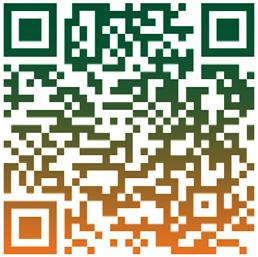
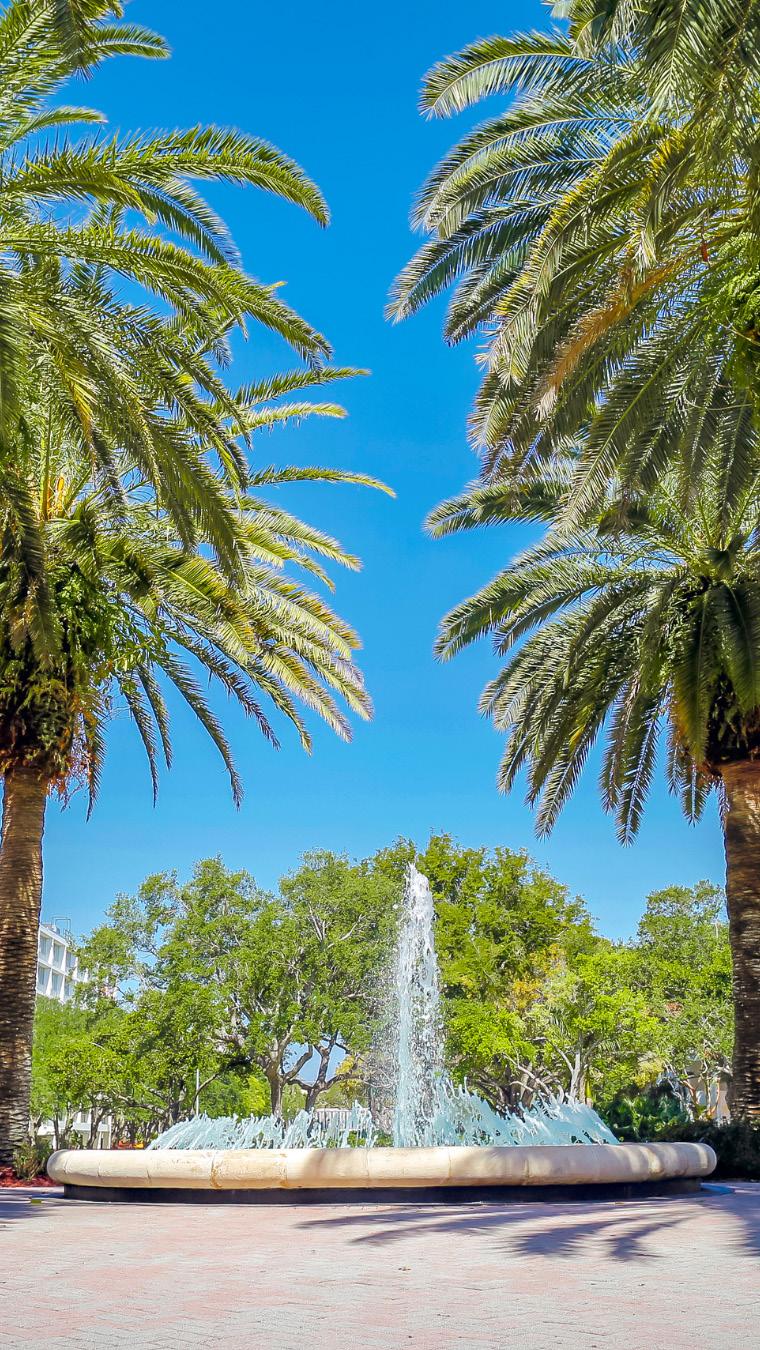
ship—afforded only to individuals whose decades of dedication and contributions to the organization were considered above and beyond in the truist sense of the term for their commitment to the great game of football.
Christian Diez, B.S. ’00, M.D. ’04, M.B.A. ’13, was appointed to the American Board of Anesthesiology. He is vice chair for clinical affairs in the Department of Anesthesiology and associate professor of clinical anesthesiology at the University of Miami Miller School of Medicine. He is an associate examiner for the American Board of Anesthesiology and serves as a committee chair for the American Society of Anesthesiologists.
Esther M. Gonzalez, M.S.Tx. ’00, joined Grove Bank and Trust as a senior director/senior wealth advisor.
Natalie B. Hundhausen, B.B.A. ’00, rejoined Guardian in 2022 as managing director of the St. Louis office.
John Katsoulis, M.B.A. ’00, has released his debut novel, “Feral Eye of the Blackbird: A Journey Reveals the Power of Reason.” It is available for purchase through Amazon and Barnes and Noble.
Kathleen A. Shea, M.P.H. ’00, founded the National Organization for Tardive Dyskinesia, the only national nonprofit charity to represent the now estimated 600,000 U.S. citizens with some form of tardive dyskinesia, a movement disorder.
Cynthia J. Cochran, B.B.A. ’01, M.P.A. ’06, is a 2022 recipient of Omicron Delta Kappa’s Cheryl M. Hogle Distinguished Service Award. She is the owner of SMT Grant and Nonprofit Services, based in Bentonville, Arkansas.
William R. Tallman, M.S.Ed. ’01, Ed.D. ’15, was awarded Delta Chi’s highest honor of Order of the White Carnation. It is awarded only to those who give consistent and meritorious service to at least one and preferably several chapters of the fraternity.
Regan N. Hertzler, B.S. ’02, is building a career in environmental regulations, sustainability, and how those issues interconnect with national security.
Leopoldo Llinas, B.S. ’02, Ph.D. ’08, was selected as the Village of Palmetto Bay Mayor’s Environmentalist of the Year. He authors columns in the com-
munity newspapers tackling a range of environmental topics from mangroves to ocean acidification. Llinas created the Blue Stewards Certificate Program, which blends traditional education with scientific research in Miami and around the globe.
Jaynelle T. Pemberton, B.S.A.E. ’02, B.S.C.E. ’02, received the Black Engineer of the Year Award, presented by Congresswoman Stacey Plaskett. The award recognizes the leaders who are developing innovation across STEM fields.
Truman L. Tinsley, J.D. ’02, graduated from the U.S. Army War College at Carlisle Barracks, Pennsylvania, with a master’s degree in strategic studies in June 2022.
Gabriel A. Dieppa, M.B.A. ’03, has been named managing partner for Hotaling Insurance Services.
LaVern M. George, B.A. ’03, was promoted to safety and pharmacovigilance lead at Syneos Health.
Kourtney Gibson, B.B.A. ’03, was appointed chief institutional client officer by TIAA, a leading provider of secure retirements and outcomefocused investment solutions to millions of people and thousands of institutions. She is responsible for serving more than 15,000 retirement plan sponsors in the academic, research, medical, and cultural fields and their consultants.
David H. Davies, M.M. ’04, D.M.A. ’07, was named as provost of Houghton College in Houghton, New York. He serves on the board of directors as the chair of Region 6 for the National Association of Schools of Music and is the vice president of the Northeast Chapter of the College Music Society
Jason P. Ballard, B.B.A. ’05, launched Primetime Elevation, a performance coaching and time and energy management company.
Kelly L. Fishman, B.S.C. ’05, works for the Anti-Defamation League as the education director in Cleveland. She is working to increase antibias and antibullying education within her region.
Michael T. Hayes, LL.M.E. ’05, was one of eight lawyers included in the 2023 edition of The Best Lawyers in America by Grant Fridkin Pearson, P.A.
Eldonie S. Mason, J.D. ’05, released her children’s book “The Adventures of Princess Anyah of Antibarba: The Fishing Expedition.” It depicts the adventures of a young Caribbean princess.
Andres F. Lavin, B.S.E.E. ’06, moved to Panama City to be assigned to Tyndall Air Force Base after being stationed in California for more than seven years.
Evan A. McGill, B.B.A. ’06, coproduced “The Music Man 2022 Broadway Cast Recording” featuring Hugh Jackman and Sutton Foster.
David I. Schwach, B.Arch. ’06, is in his 10th year as a certified anesthesiologist assistant in The Woodlands, Texas.
Erin R. Applebaum, B.A. ’07, was selected to the Plaintiffs’ Executive Committee for the ongoing 737 MAX litigation against Boeing.
Adam D. Greenberg, B.S. ’07, is among the first Peace Corps volunteers to return to overseas service since the agency’s unprecedented global evacuation in March 2020 at the onset of the COVID-19 pandemic. He will serve as a volunteer in Zambia in the agriculture sector.
Anthony L. King, B.L.A. ’07, was a professional athlete for the past 14 years in Europe. He recently retired and is now a financial representative.
John “Brad” Rohrer, M.S. ’07, has been appointed vice president and chief information officer at the University of Miami. He has been a part of the University community for nearly 25 years.
Ryan J. Beadle, LL.M.T. ’08, has joined Grant, Fridkin, Pearson P.A.’s trusts and estates groups as counsel. He has practiced law for 14 years and has experience with a variety of practices.
Elsa C. Bolt, B.S.C. ’08, is an Emmy Award-winning executive news producer. Bolt has spent most of her career with WPLG—Local 10 News.
Akilah A. Quallo, B.S.N. ’08, is a 2022 Legacy 40 Under 40 South Florida Honoree.
Kemal O. Yariz, Ph.D. ’08, received the Professor of the Year award at New York College of Podiatric Medicine.
Jimmy A. Escobar, B.B.A. ’09, vice president and practice director at Robert Half Talent Solutions, qualified for President’s Club last year for the fourth year in a row.
Eric L. Golnick, B.A. ’09, M.A. ’14, is the co-founder of Forge Health and CEO of Forge VFR, which provides specialized mental health and substance use treatment to veterans and first responders.
Jennifer G. Denk, B.M. ’10, M.M. ’20, is assistant professor of music therapy at the University of Georgia.
Alexander J. Schosheim, B.A. ’10, started as a pediatric gastroenterologist at RWJBH-Monmouth Medical Center in 2021 and was appointed clinical assistant professor of pediatrics at Robert Wood Johnson School of Medicine in 2022.
Dana M. De Carlo, B.S.C. ’11, completed her fellowship training in New York and returned to Miami to join the Division of Pediatric Cardiology at Nicklaus Children’s Pediatric Specialists.
Lisandra Ortiz, B.B.A. ’11, was elected as member of the firm Miller & Chevalier. Ortiz concentrates her practice on federal tax controversy matters, both in litigation and before the Internal Revenue Service in examinations and appeals.
Justin H. Pressman, B.M. ’12, was appointed executive director of American Friends of the Hebrew University, Western Region. He will develop regional strategic campaign plans, as well as implement and evaluate major giving campaigns in support of the Hebrew University of Jerusalem, Israel’s premier academic institution and research powerhouse.
Grace-Anne N. Stimpson, B.S.N. ’12, is currently working at UMC Health System in Lubbock, Texas, as a registered nurse in the Family Birth Center as well as relief house supervisor. Stimpson also maintains her practice as a psychiatric nurse practitioner treating children and adolescents via telehealth.
Stephanie V. Dierickx, B.M. ’13, is co-owner of Sweet Lich’s (pronounced “sweet licks”), a small family-owned business founded by Erik “The Baker” and his wife, Steph “The Boss.”
Alexander J. Monje, B.S.C. ’13, J.D. ’17, was named chairman of the board of Nubia Brand International Corp., a special purpose acquisition company listed on the NASDAQ.
Rachel G. Allen, M.S.Ed. ’14, was promoted to camp director at Congregation B’nai Israel.
Kristen Calzadilla, B.A. ’14, J.D. ’21, joined the Bressler, Amery &
Motivated by the current public health crisis and decades of working to fight HIV, Daniel Feaster, professor of biostatistics in the Department of Public Health Sciences at the University of Miami Miller School of Medicine, and his late husband, Michael Uselmann, senior research associate, chose to honor their life’s passion by creating the department’s first endowed chair through a planned gift. Their gift will also endow research and fellowship funds.

You, too, can create a legacy at the University to support causes that are deeply important to you. Through a bequest in your will or trust, or a gift through your IRA, you can help power advancements in research, support student scholarships, or help recruit exceptional faculty members.
–Dr. FeasterTo learn about the many simple and easy planned giving vehicles available to make a lasting impact at the U, please contact Kyle Paige, executive director, Office of Estate and Gift Planning, at 305-284-2914 or kpaige@miami.edu.
VISIT US AT MIAMI.EDU/PLANNEDGIVING

“
We were both strongly committed to leaving a legacy that could accomplish something meaningful.”
Ross firm as an associate in the insurance litigation group in the firm’s Fort Lauderdale office. Before joining Bressler, she worked as a law clerk at a Florida law firm in the banking and finance department.
Ryan P. Forrest, J.D. ’14, an attorney in the Miami office of Littler, the world’s largest employment and labor law practice representing management, has been accepted into the Leadership Miami Class of 2022 and appointed to the Florida Bar Federal Court Practice Committee by its president.
Wyatt D. Krapf, B.S.C.E. ’14, M.S.C.E. ’14, was named to the Tampa Bay Business Journal’s 2022 “40 Under 40” list.
Jordan A. Shaw, J.D. ’14, represented a class of patients who were improperly billed, resulting in the Jacksonville Area Legal Aid receiving a $51,356 Cypress Award. He is a partner at Zebersky Payne Shaw Lewenz, LLP, chairs the firm’s Consumer Litigation Practice Group, and co-chairs its Commerical Litigation Practice Group.
Daniel J. Dodge, B.S. ’15, joined Gibbons P.C. as a corporate group associate in the New York office.
Recently, he was a senior associate at Ernst & Young LLP, where he drafted and analyzed tax documents for various tax-related exposures and issues.
Jaydev S. Hemrajani, B.B.A. ’15, B.S.C. ’15, co-wrote and co-produced the short film “Cariño,” which was selected to premiere at the Miami Film Festival. The film won the Audience Award for Best Short Film.
Dykisha J. Potter, B.S.B.A. ’15, is a 2021 recipient of the Jacksonville University MPP Minority Policy Fellowship.
Jesse C. Salvo, B.S.C. ’15, author and publisher, published his first novel, “Blue Rhinoceros,” and went on a book publicity tour around the country.
Amber M. Altidor, B.S.N. ’16, is a psychiatric and mental health nurse practitioner in Chicago.

Demetrius A. Jackson, B.A. ’17, M.A.L.S. ’19, started his own sports agency, Tailored Sports Group.
Harry Levine, B.A. ’17, B.S. ’17, M.D. ’22, M.P.H. ’22, matched at the University of Michigan for residency in ophthalmology.
Christopher Ortiz, M.A. ’17, is a senior application sales executive at AT&T, providing next-generation technology solutions for public sector customers in Texas within K-12 and higher education agencies.
Ela M. Rosier, B.A. ’17, is CEO of Kidokinetics Orlando, CEO of QB country Tampa, and CEO of Miami Millionaires club.
Vasisth R. Sewnarainsukul, B.S.C. ’17, co-wrote and co-produced the short film “Cariño,” which was selected to premiere at the Miami Film Festival. The film won the Audience Award for Best Short Film.
Alex J. Titus, M.B.A. ’17, released his first book based on fatherhood. The first-time author recently published the story about lessons he learned from his father and how those fundamental principles shaped his approach to business, leadership, and what he values most. Titus is president of United Franchise Group, the global leader for entrepreneurs, and Signarama, the world’s largest sign and graphics franchise.
Stephanie M. Velasco, B.B.A. ’17, M.S.Acc. ’18, relocated to San Francisco from Miami/New York City and has transitioned into the mergers and acquisitions deals advisory line of service at PricewaterhouseCoopers.
Brian A. Barcelo, B.S.C. ’18, served as the camera operator for the short film “Cariño,” which was selected to premiere at the Miami Film festival. The film won the Audience Award for Best Short Film.
Alexander V. Besmer, B.S. ’18, is an orthodontics resident at Saint Louis University.
Andre K. Buchanan, B.A. ’18, received his M.S. in computer science from Texas Southern University in 2021, then accepted a role at Salesforce as a technical consultant. He is seeking business-focused co-founders for his tech startup for athletic wearables.
Corbet C. Campbell, B.M. ’18, is a cannabis business owner and received the 2022 Best Cannabis Dispensary in New England NECANN award.
Vivian A. Heerens, B.S.C. ’19, was appointed to the Indiana Behavioral Analyst Committee by Governor Eric Holcomb. The governor appointed five individuals to the new committee who will serve until Dec. 31, 2025.
Fernanda Lamuno Cabanas B.B.A. ’19, served as director of photography, and editor of the short film “Cariño,” which was selected to premiere at the Miami Film Festival. The film won the Audience Award for Best Short Film.
Luke P. Jones, B.B.A. ’20, is a Lux Charter specialist at Boatsetter, seeking to help improve the marine industry in South Florida and increase entrepreneurship.
Tahzeeb A. Rashid, M.S.F. ’20, was promoted from analyst to associate at Cassel Salpeter & Co.
Wei Yan, B.B.A. ’20, M.S.Acc. ’21, joined the accounting and advisory firm McGregor & Company, LLP as a staff accountant.
Daniel M. Avila, B.S.C. ’21, started a new job as a marketing assistant for his hometown community bank.
Sofia E. Hamilton, B.A. ’21, moved to Washington. D.C., to work with the Cato Institute.
Thomas Horrego, M.B.A. ’21, accepted an offer from Wells Fargo and relocated to Charlotte, North Carolina.
Rebecca A. Hunt, Ed.D. ’21, who graduated with a focus in higher education leadership, was promoted to director of advanced studies for Orange County Public Schools.
Oscar Rodriguez, M.B.A. ’21, has been appointed to the new head of analytics role with LCH, an LSEG company.
If too many copies are reaching your mailbox, simply send an email to alumni@miami.edu with “Seeing Double” in the subject line or call 1-866-UMALUMS to update your mailing preferences.
Abigail L. Griffith, B.S.I.E. ’18, founded Clarity Fitness, Georgia’s first weight-inclusive, eating disorderinformed, wellness center just outside of Atlanta.
Gabriel M. Nunez, B.B.A. ’18, moved to San Francisco for a new job in the private equity industry.
Kenya S. Rothstein, J.D. ’21, authored a paper on sustainability, reporting that was cited by the SECs recent proposed rule on climate disclosures.
Jiucheng Ding, B.S. ’22, received admission to Cornell University’s Master of Engineering program in biomedical engineering.
William J. Hoy, B.S.M.E. ’22, is a Ph.D. candidate in industrial engineering.
Donor-funded scholarships extend the promise of a University of Miami education to the most promising students. They light the way for the next generation of bold thinkers, inspiring artists, daring innovators, compassionate caregivers, and global leaders.




Yet, the cost of attending a private, top-tier institution like the U often creates a financial strain that cannot be alleviated through the combination of public and private aid currently available. With your support, our students can overcome financial obstacles, pursue their passion and purpose, expand their academic horizons, and apply their education in transformative ways.
Please support the General Scholarship Fund and help ’Canes make their educational dreams a reality.

To learn more, contact the Office of Philanthropic Giving at 305-284-2872 or philanthropicgiving@miami.edu.

The University of Miami Alumni Association notes the passing of the following graduates.
Atalie B. Lebedeff, B.A. ’40
W. K. Phillips, B.B.A. ’43
Carol L. Boyett, B.A. ’46
Bernice D. Strauss, B.A. ’47, M.A. ’49
Joan F. Evans, B.A. ’48
Alan V. Iselin, B.A. ’48
Charles E. Paoli, B.S. ’50, J.D. ’60
Betty O. Rice, B.M. ’50, M.M. ’74
Patricia A. Cugno, B.A. ’51
Thomas S. Norwalk, B.A. ’51
Irving L. Cooper, B.B.A. ’52
Richard W. King, B.B.A. ’52
Joanne H. Mercurio, B.A. ’52
Thomas B. DeWolf, J.D. ’53
Edward W. English, B.A. ’53
William Samardak, B.A. ’53
Niles B. Cooney, B.B.A. ’54
Gerald E. Gill, B.B.A. ’54
Beverly C. Stapleton, B.B.A. ’54
Mary L. Brotherson, B.Ed. ’55
Dale L. Fidel, B.A. ’55
Shirley H. Spiegelman, B.A. ’55
Charles D. Tomlinson, B.A. ’55
Jeanne C. Baxter, B.A. ’56
Errol L. Clark, B.Ed. ’56, M.Ed. ’58
Jerry E. Exum, B.Ed. ’57
Edward L. Middlebrooks, B.B.A. ’57, J.D. ’60
Henderson A. Pate, B.A. ’57
Sam Scarnecchia, B.Ed. ’57
Alvin M. Chester, B.B.A. ’58
Philip R. Deville, B.B.A. ’58
Melvin Hecht, B.B.A. ’58
Stephen G. Herrold, B.M. ’58
Robert W. McGee, B.Ed. ’58, M.Ed. ’60
Clarence B. Stortz, M.S. ’58
Edward M. Contreras, B.B.A. ’59
Patricia M. Eaton, B.S.N. ’60
Paul H. Tocker, B.B.A. ’60
Henry A. Cacciatore, M.D. ’61
George C. Clark, M.S. ’61
Bernard J. Fogel, M.D. ’61
Stephen C. Margolis, B.S. ’61, M.S. ’65, M.D. ’69
Loretta A. Rogers, B.A. ’61
David S. Cannava, B.B.A. ’62
James C. Collins, B.B.A. ’62
Malinda J. Mortin, B.B.A. ’63
Charles D. Smith, B.S.E.E. ’63
John J. Roman, B.Ed. ’64
Jack W. Collier, B.S. ’65
Stuart D. Perlman, B.B.A. ’65
Martha D. Sheppard, B.Ed. ’65
Leon T. Cristiano, B.B.A. ’66
Norman J. Bonchick, B.B.A. ’67
Earleen A. Hammond, B.A. ’67
John W. Hoover, B.B.A. ’67
Kenneth M. Kone, M.B.A. ’67
Susan E. Orr, B.Ed. ’67
Melvin C. Seid, B.S.E.E. ’67
Jeffrey J. Waxman, B.A. ’67
John K. Bobb, B.A. ’68, J.D. ’74
Jose J. Noy, B.S. ’68, M.D. ’72
Robert Rosen, B.B.A. ’68, M.B.A. ‘71
Richard Hill, M.Ed. ’69
Michael M. Exelbert, B.Ed. ’70, M.Ed. ’75
Robert A. Freeman, J.D. ’70
Thomas Sleeper, conductor of the Frost School of Music’s Frost Symphony Orchestra for 25 years and director of the Florida Youth Orchestra for 27 years, died in October after a courageous battle against Amyotrophic Lateral Sclerosis (ALS). He was 66 years old.

Sleeper began his professional career as a member of Fermata, a group of composers and performers who presented concerts throughout the state of Texas. At age 22, he was appointed associate conductor of the Dallas Civic Symphony and the SMU Chamber Orchestra and Opera Theatre, where he began studies with Maestro James Rives-Jones.
An active guest conductor, Sleeper appeared with such orchestras as the Central Philharmonic of China, San Juan (Argentina) Symphony Orchestra, Ruse State Philharmonic, and China-Wuhan Symphony, which appointed him artistic advisor in 1993. He has recorded on the Albany, Centaur, Naxos, Cane, Irida, and Vienna Modern Master labels, and his compositions have been performed throughout the United States and in Europe, Asia, and South America. His output includes six operas, 15 concerti, five symphonies, four orchestral song cycles, works for chorus with orchestra, three string quartets, numerous other vocal and instrumental chamber works, and music for film, including “One Water,” a collaborative project at the University of Miami that brings awareness to the global water challenge.
Louiseann C. Kellner, B.Ed. ’70
Hector S. Vergara, B.S.M.E. ’70
Barbara Gaynor, M.Ed. ’71
Susan D. Skor, M.Ed. ’71
Inaki Saizarbitoria, B.S.E.E. ’72, M.B.A. ’73, J.D. ‘79
Frederick D. Lather, M.B.A. ’73
Marilyn M. Grivjack, M.Ed. ’74
Robert S. McQuilkin, B.Ed. ’74
Scott B. Tarabour, B.M. ’75
Ray Liotta, B.F.A. ’77
Mark B. Schorr, J.D. ’77
Marianna Vaughan, M.B.A. ’78
John K. Williams, B.B.A. ’78
Mark R. Houck, J.D. ’79
John M. Brennan, B.M. ’80
Roberta E. Robbins, J.D. ’81
Charles L. Balli, B.A. ’83, J.D. ’86
Gino Vitiello , B.S. ’83, M.D. ’88
Laurence M. Andress, J.D. ’86, LL.M.T. ’92
Lisette Z. Filpi, B.A. ’86
Corey L. Hart, M.B.A. ’86
Timothy G. Dowling, B.B.A. ’87
David Kohl, B.B.A. ’88
Carol B. Lee, M.M. ’93
Joseph F. Calapai, B.S.C ’94
Javier Lopez-Casado, M.B.A. ’03
Sarah L. Stanczyk, B.B.A. ’05
Stephanie S. Altman, M.A.L.S. ’11
Names recorded as of Oct. 1, 2022. We research each name, but errors can occur. Please email any corrections or clarifications to alumni@miami.edu or call 305-284-2872.
Alumni records of the University of Miami are kept strictly confidential. Directory information is released only to other members of the alumni community unless an alumnus or alumna has requested complete privacy. On a very limited occasion and only at the approval of the Alumni Association Board of Directors, directory information is shared with outside vendors who are in a joint relationship with the University. Should you wish to not release your name to any outside vendor and/or other members of the University alumni community, please notify the Office of Engagement in writing at P.O. Box 248053, Coral Gables, Florida 33124-1514.
Christopher J. Chen, B.S. ’97, M.D. ’00
Carolyn B. Lamm, J.D. ’73
Alice S. Vilma, B.B.A. ’99
Preston J. Clark, J.D. ’08
Jerry P. Goldstein, B.B.A. ’89
MacKenzie Green, B.S.C., ’10
Michael F. Guilford, J.D. ’85
Felicia Hale, B.B.A. ’00
Jose A. Hernandez-Solaun, M.B.A. ’05
Rachel S. Highland, B.S.B.E. ’05, J.D. ’08, M.S. ’09
Thomas F. Juhase, M.B.A. ’89
Jodan H. Ledford, M.S. ’05
Bryan Lewis, M.B.A. ’04
Marilu Marshall, B.B.A. ’66, J.D. ’69
Elise G. Morales, B.S.N. ’77, M.S.N. ’81
Javier E. Morgado, B.S.C. ’99
David Mullings, B.S. ’00, M.B.A. ’03
Maria I. Nardi, B.Arch. ’91
Roberto L. Palenzuela, B.B.A. ’84, J.D. ’88
Nilesh K. Parikh, B.B.A. ’05
Mark F. Raymond, J.D. ’83
Angela M. Recio-Sondon, B.S.C. ’91
Robert D. Rubin, J.D. ’84
John A. Ruzich, B.S.C. ’96
Lila J. Snyder, B.S.M.E. ’94
Juliana R. Wheeler, B.A. ’92, M.A. ’94
Max T. Myers, B.B.A. ’11, President
Brianna P. Hathaway, B.A. ’16, President-Elect
Debbie Anglade, M.S.N. ’10, Ph.D. ’14
Christian Diez, B.S. ’00, M.D. ’04, M.B.A. ’12
Jamie Williams-Smith, President of Student Government
Joseph Bonner, President, Graduate Student Association

Elizabeth Castano, President, Student Bar


Pia Iribarren, President, Miller School of Medicine Student Government


Brooke Anne Schaefers, Co-President, Marine Science Graduate Student Organization
Max Voehl, Co-President, Marine Science Graduate Student Organization
Atlanta Joshua E. Gray, B.S.E.E. ’12, atlantacanes@miami.edu
Boston Zoheb H. Nensey, B.A. ’10, bostoncanes@miami.edu
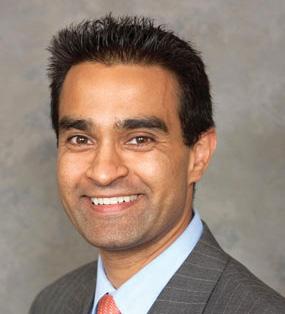
Broward County Marcie Hibbs, B.A. ’99, browardcountycanes@miami.edu
Charlotte Shannan S. Richards, B.A. ’05, charlottecanes@miami.edu
Chicago Rebecca A. Hoffman, B.A. ’92, M.S.Ed. ’94, chicagocanes@miami.edu
Colombia Carlos Largacha-Martínez, M.A. ’02, Ph.D. ’07, colombiacanes@miami.edu
Dallas-Fort Worth Alana Dombrosky, B.A. ’15, dallascanes@miami.edu
Denver Matthew M. Pollard, B.S.En.E. ’12, denvercanes@miami.edu
Detroit Justin A. Berg, B.S.En.E. ’10, detroitcanes@miami.edu
Houston Hashim Abdullah, M.B.A. ’17, houstoncanes@miami.edu
Indianapolis Soña S. Gonzales, B.B.A. ’02, indianapoliscanes@miami.edu
Kuwait Reyadh A. Al-Rabeah, B.S.I.E. ’87, kuwaitcanes@miami.edu
Los Angeles Dawn M. Minkow, B.S.C. ’12, losangelescanes@miami.edu
Louisville Michael B. Friedman. B.B.A. ’74, louisvillecanes@miami.edu
Mexico Fernando G. Valenzuela, M.B.A. ’96, mexicocanes@miami.edu
Miami Carlos E. Lowell, B.S.M.E. ’94, miamicanes@miami.edu
New York Jerry D. Goldstein, B.B.A. ’89, newyorkcanes@miami.edu
Orlando Sarah E. Chule, B.A. ’01, orlandocanes@miami.edu
Palm Beach County Connie V. Lackey, B.C.S. ’91, palmbeachcountycanes@miami.edu
Philadelphia Stephen C. Bernstein, B.A. ’13, philadelphiacanes@miami.edu
San Francisco Emily A. Salman, B.S.B.A. ’13, sanfranciscocanes@miami.edu
Sarasota Christopher L. Clayton, B.S.C. ’94, sarasotacanes@miami.edu
Saudi Arabia Taghreed Alsaraj, B.F.A. ’99, M.S.Ed. ’01, saudicanes@miami.edu
Spain Jaime J. Escalante, B.B.A. ’93, M.B.A. ’11, canesspain@gmail.com
Tallahassee Robin Dunlap, tallahasseecanes@miami.edu
Tampa Raeann B. Raisor, B.S.N. ’14,
M.S.N. ’17, tampacanes@miami.edu United Kingdom
Abdullah J. Fathi. B.A. ’13, B.B.A. 13, unitedkingdomcanes@miami.edu
Washington, D.C.
Benjamin D. Loewy, B.A. ’01, washingtondccanes@miami.edu
Band of the Hour
Robert S. Mann, B.A. ’87, M.B.A. ’89, President
Doug Thurber, B.S.E.E. ’90, President-Elect

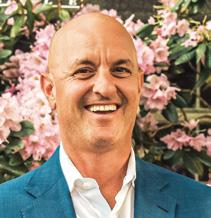
Black Alumni Society
Patricia S. Morgan, B.S. ’06, President
Astin J. Hayes, B.S.C. ’06, President-Elect
LGBTQ Alumni Association
Roberto J. Bosch, B.S.M.S. ’07, President
Aaron M. Esman, B.B.A. ’11, B.S.C. ’11, President-Elect
UM Sports Hall of Fame
Mead M. McCabe. M.B.A. ’91, President
Mike J. Ward, President-Elect
Veterans
Bryan M. Day, M.A.I.A. ’19, President
College of Engineering
Kyrah L. Williams, B.S.A.E. ’16, M.Arch. ’18, President
Miller School of Medicine
Alex J. Mechaber, B.S. ’90, M.D. ’94, President
Pilar Gutierrez, B.S. ’84, M.D. ’90, President-Elect

School of Law
Dan S. Newman, J.D. ’91, President
Stephanie L. Carman. J.D. ’01, President-Elect
School of Nursing and Health Studies
Renee L. Longini, B.S.N. ’09, D.N.P. ’16, President






















































































































































